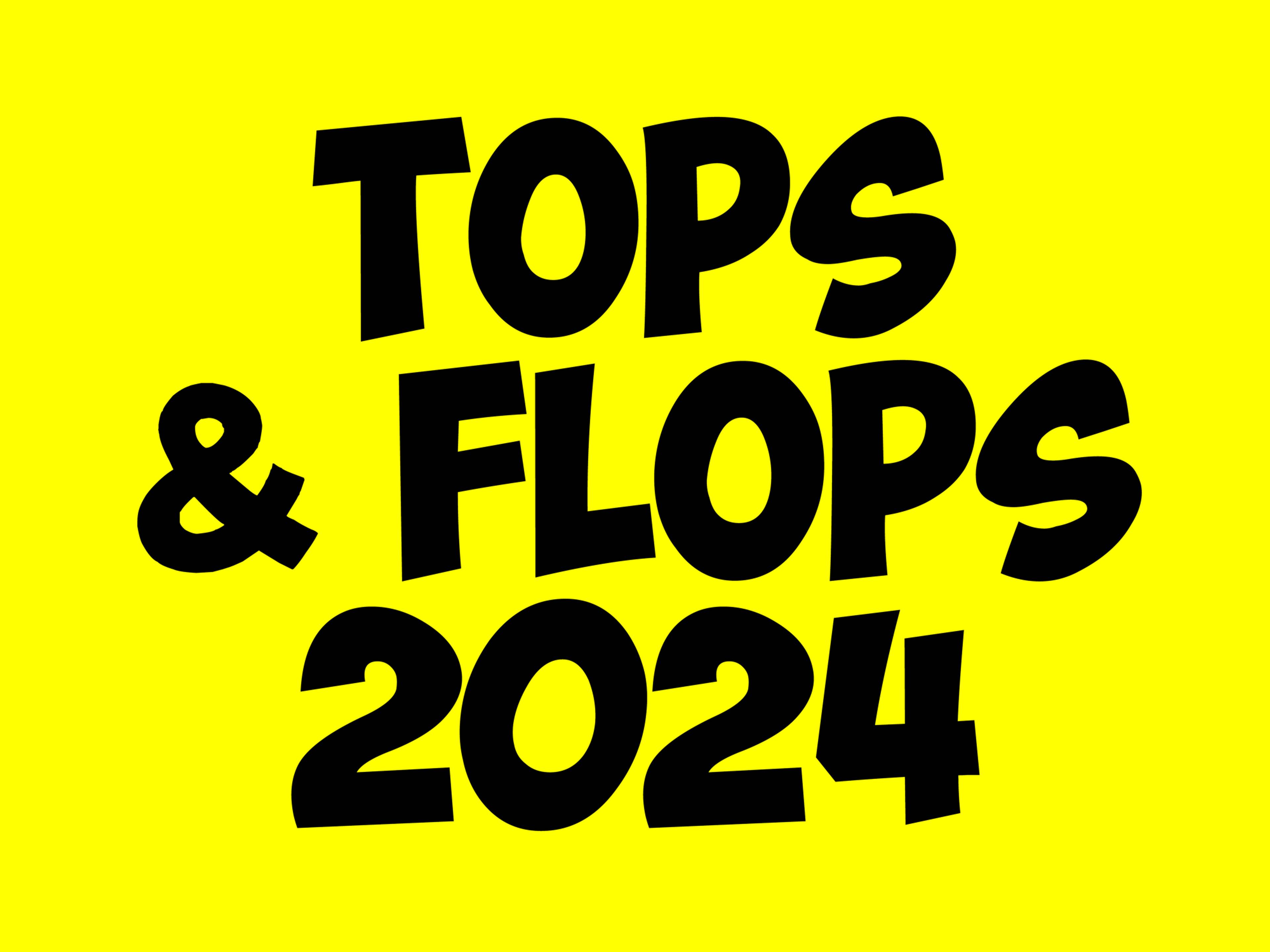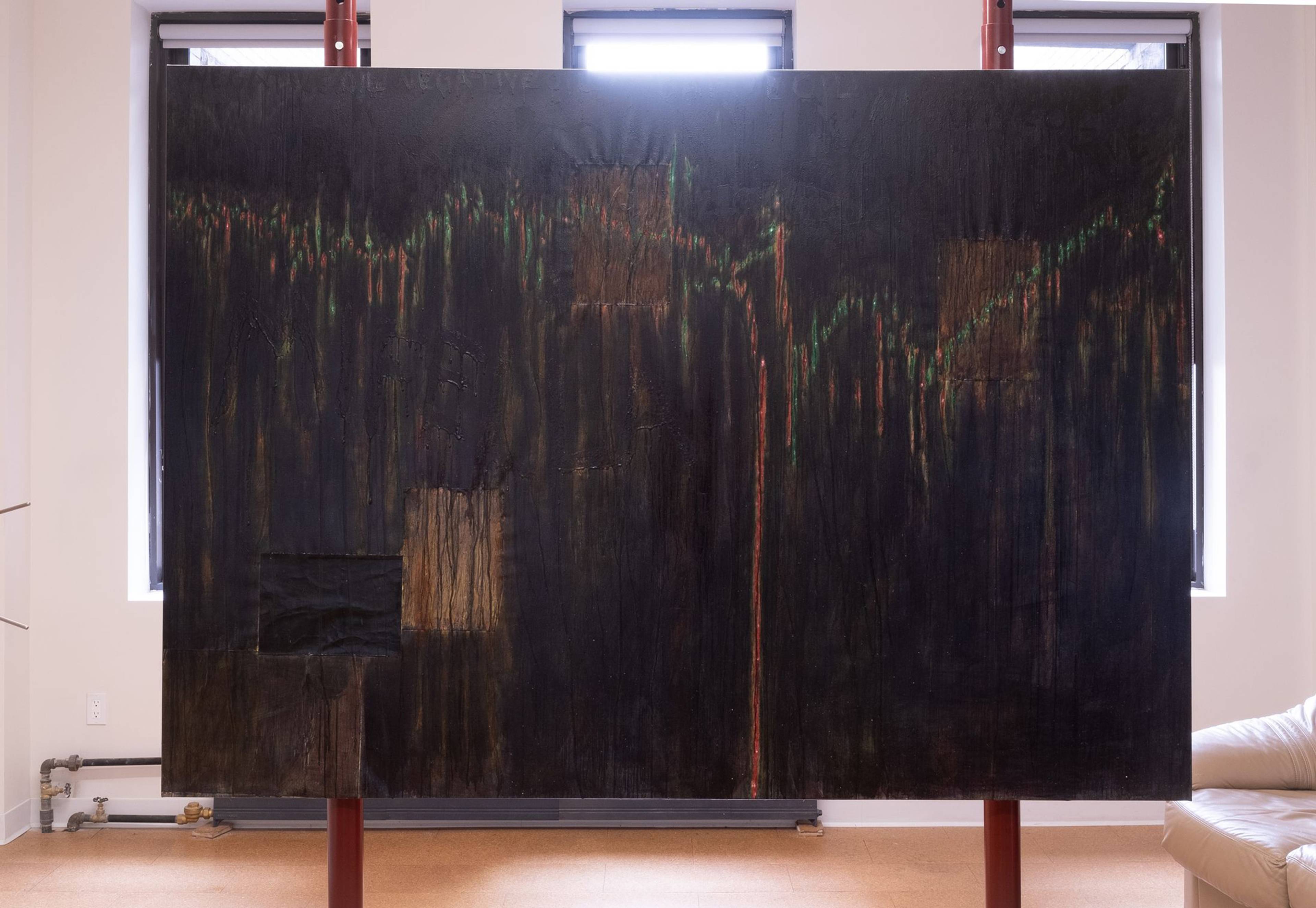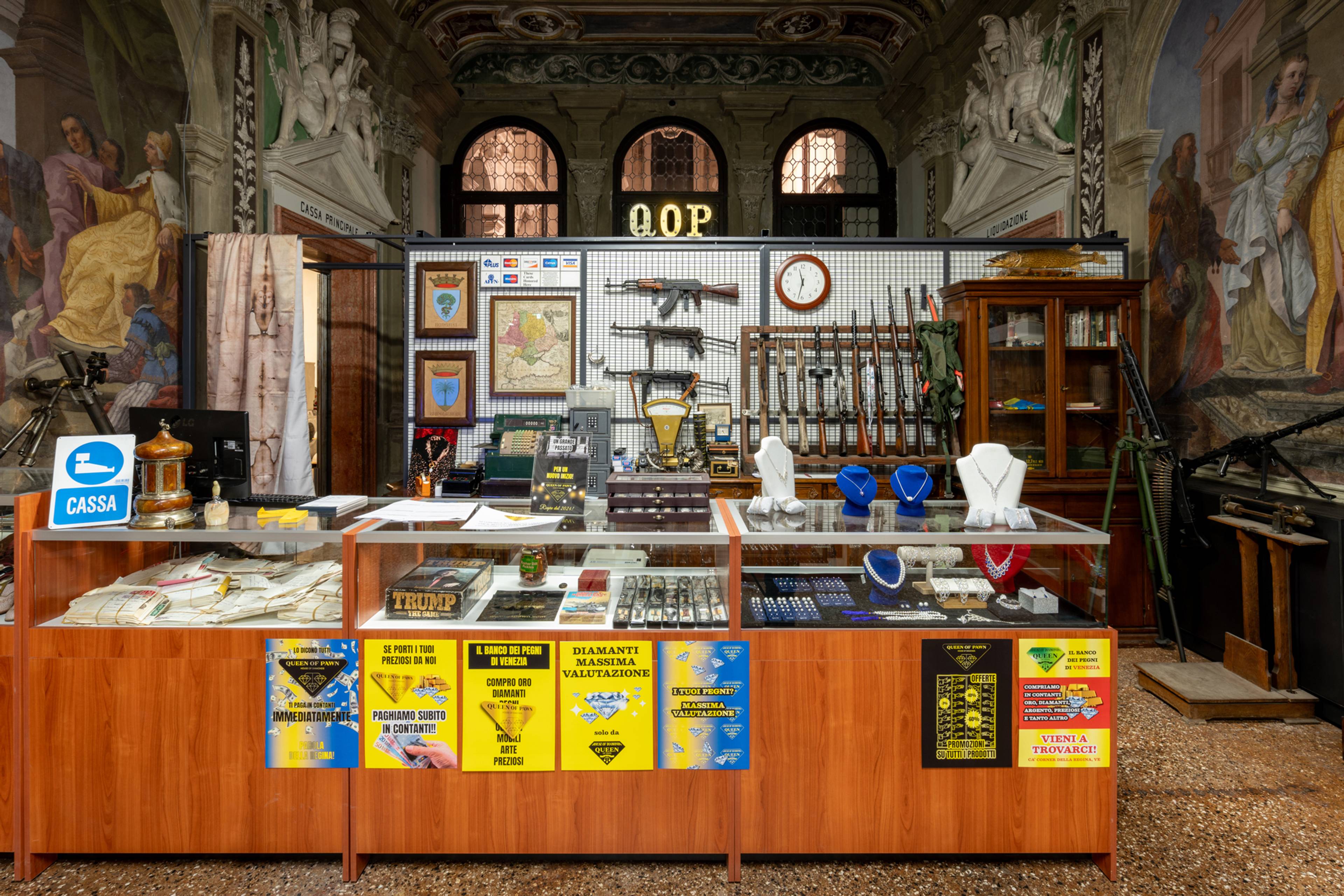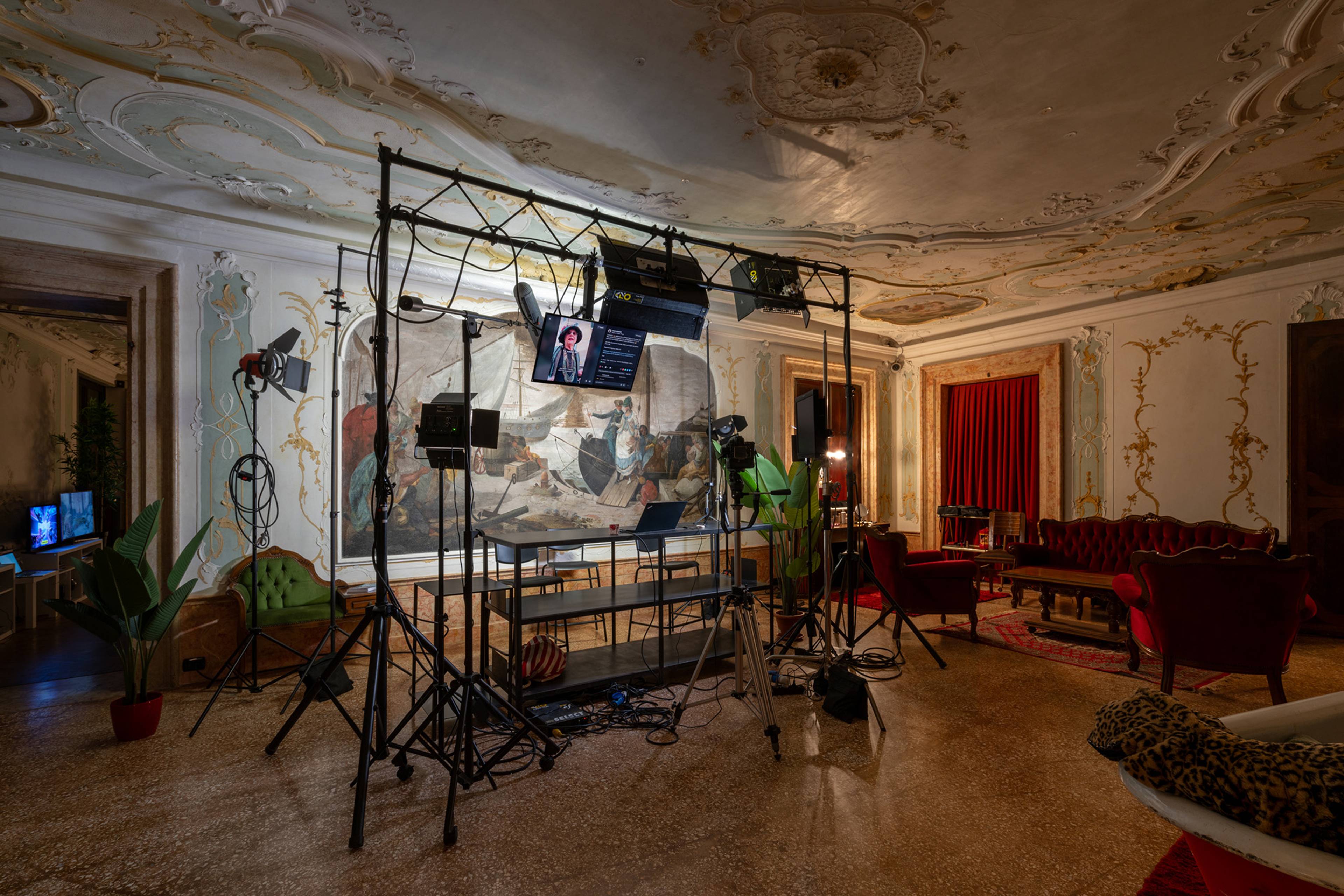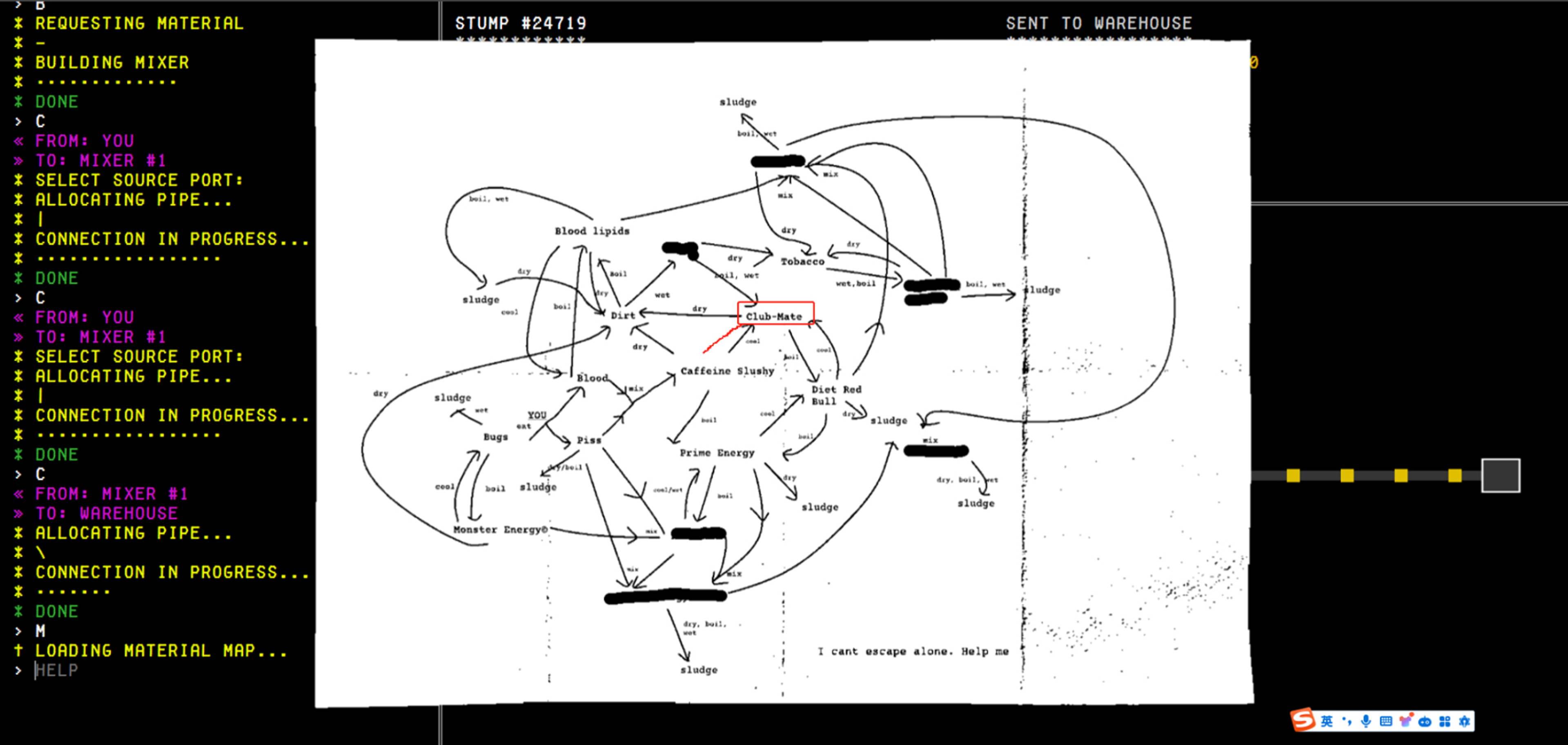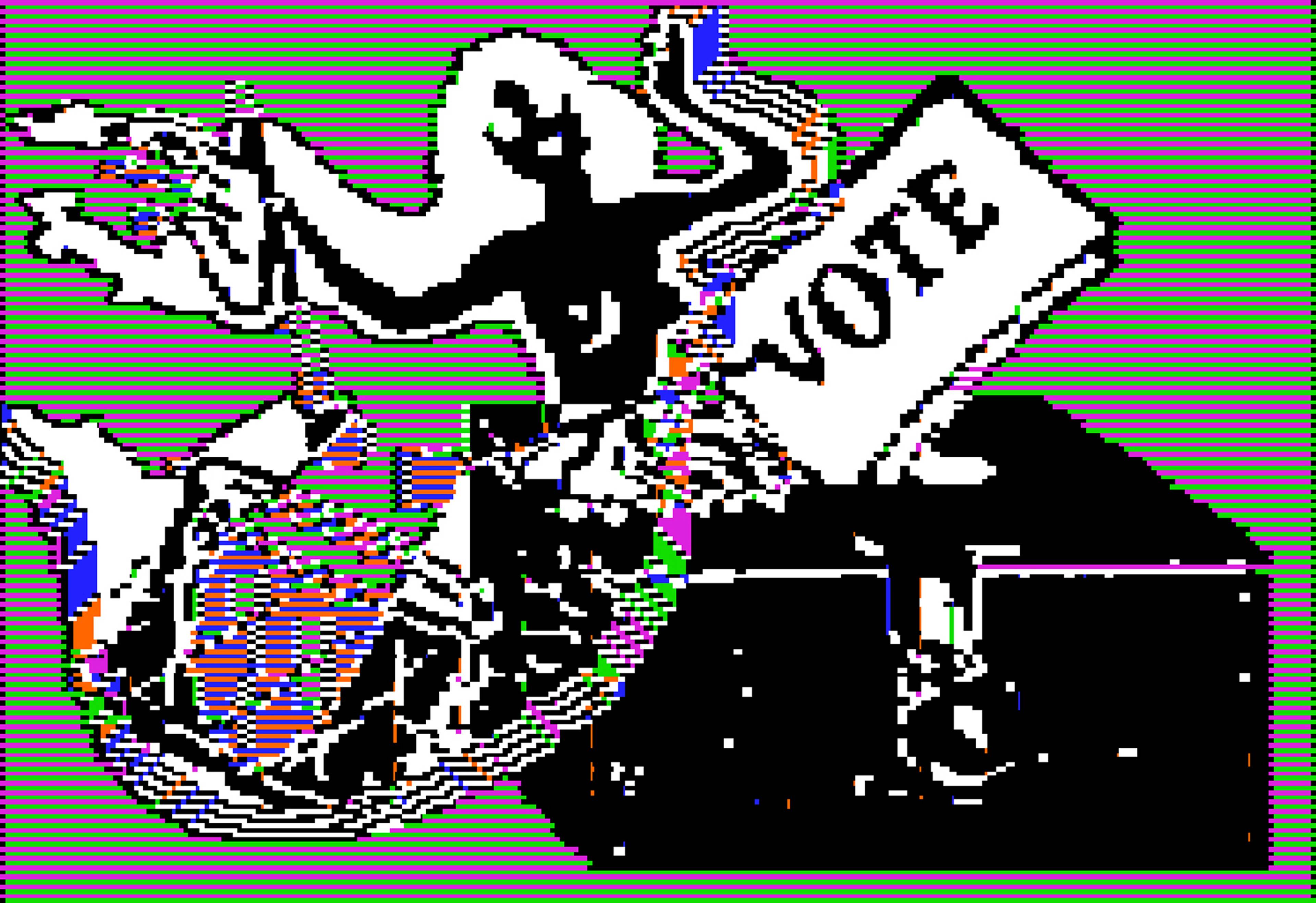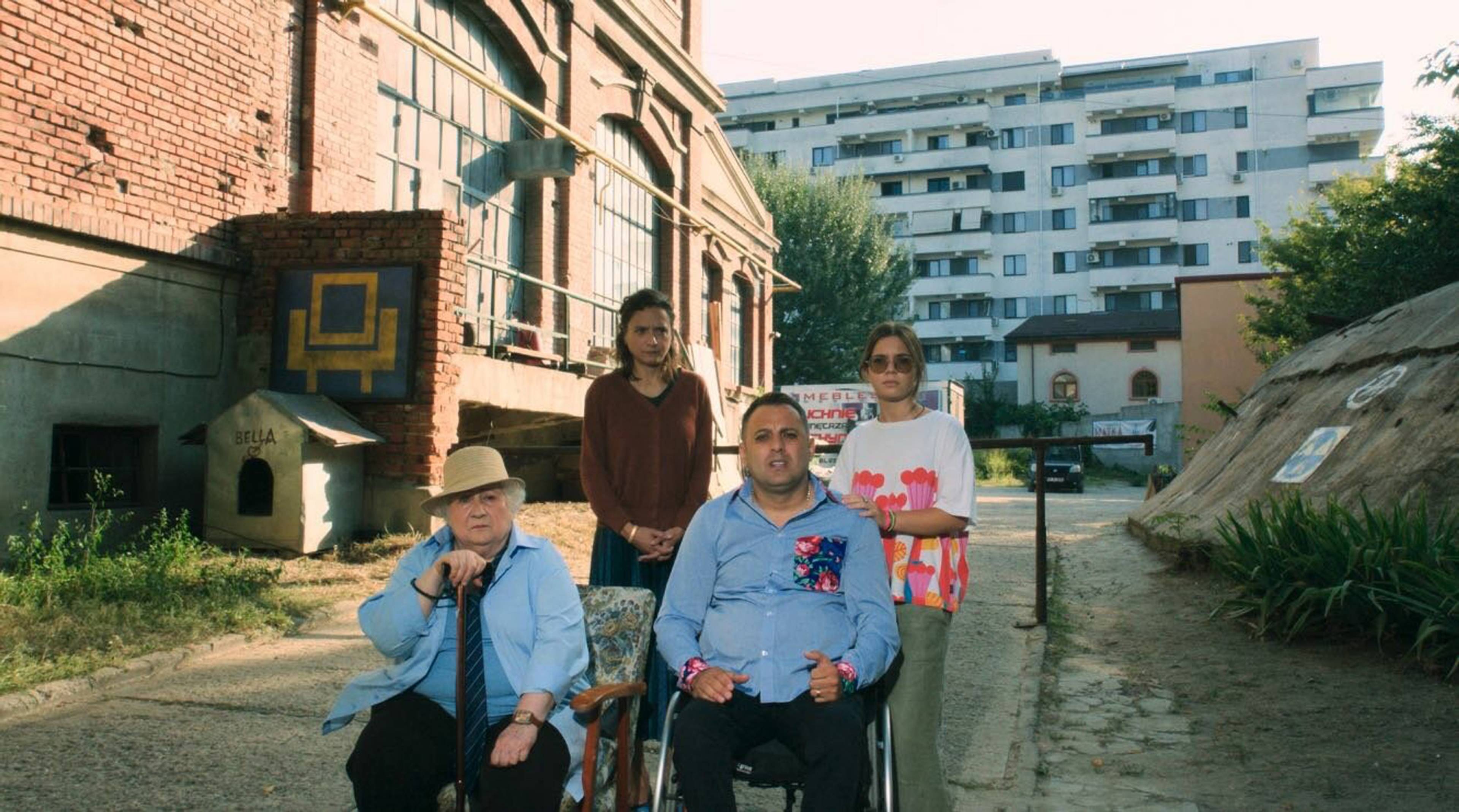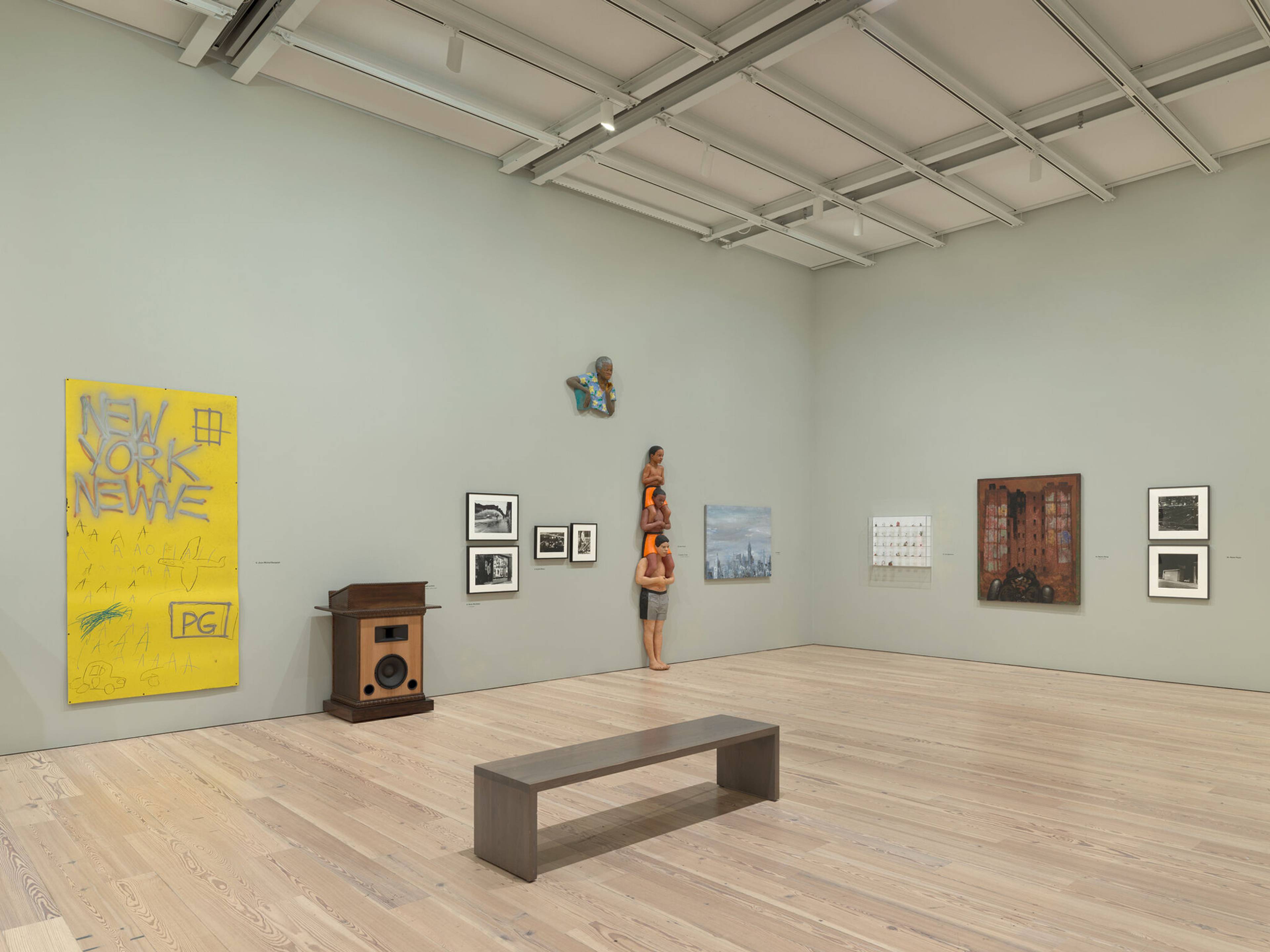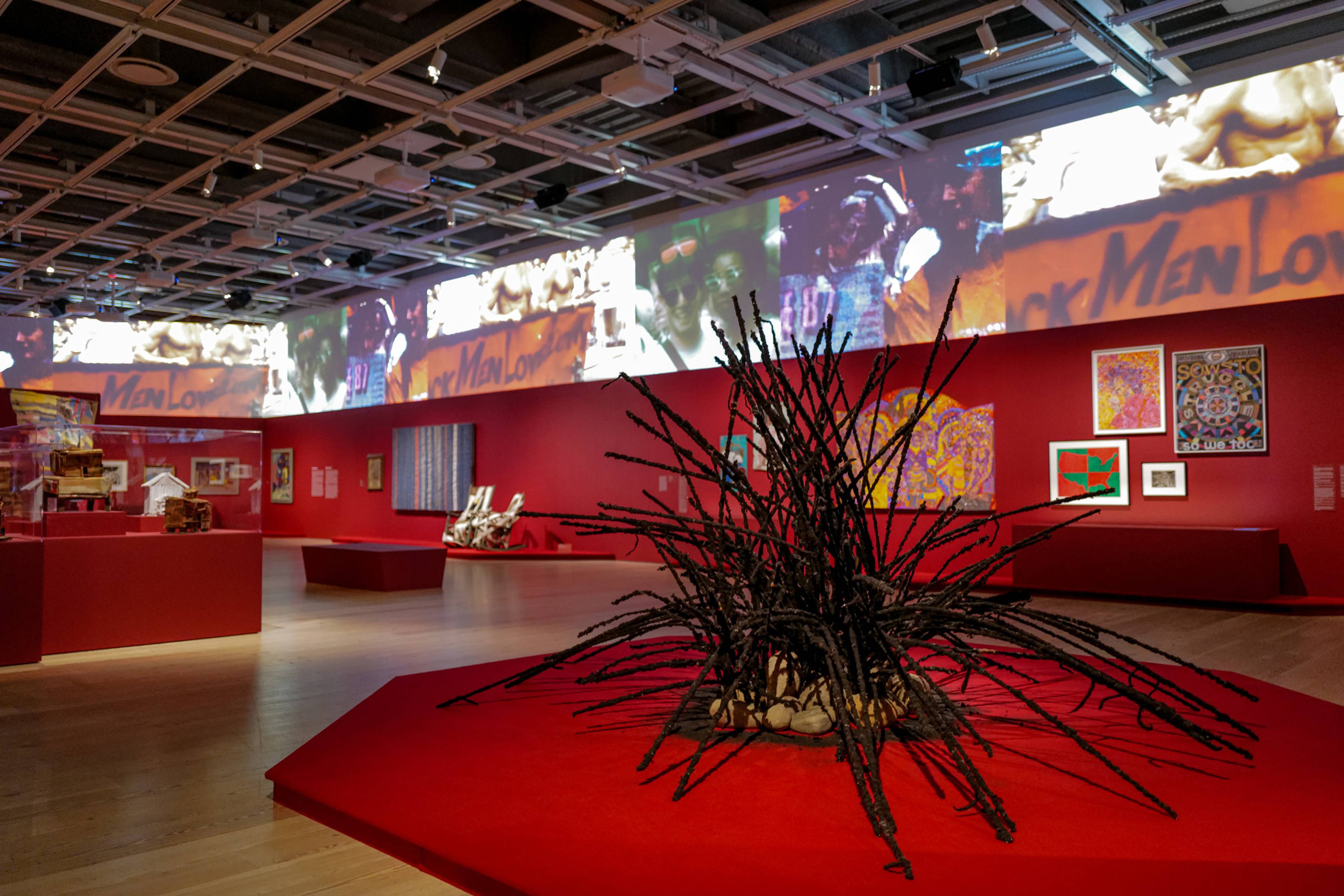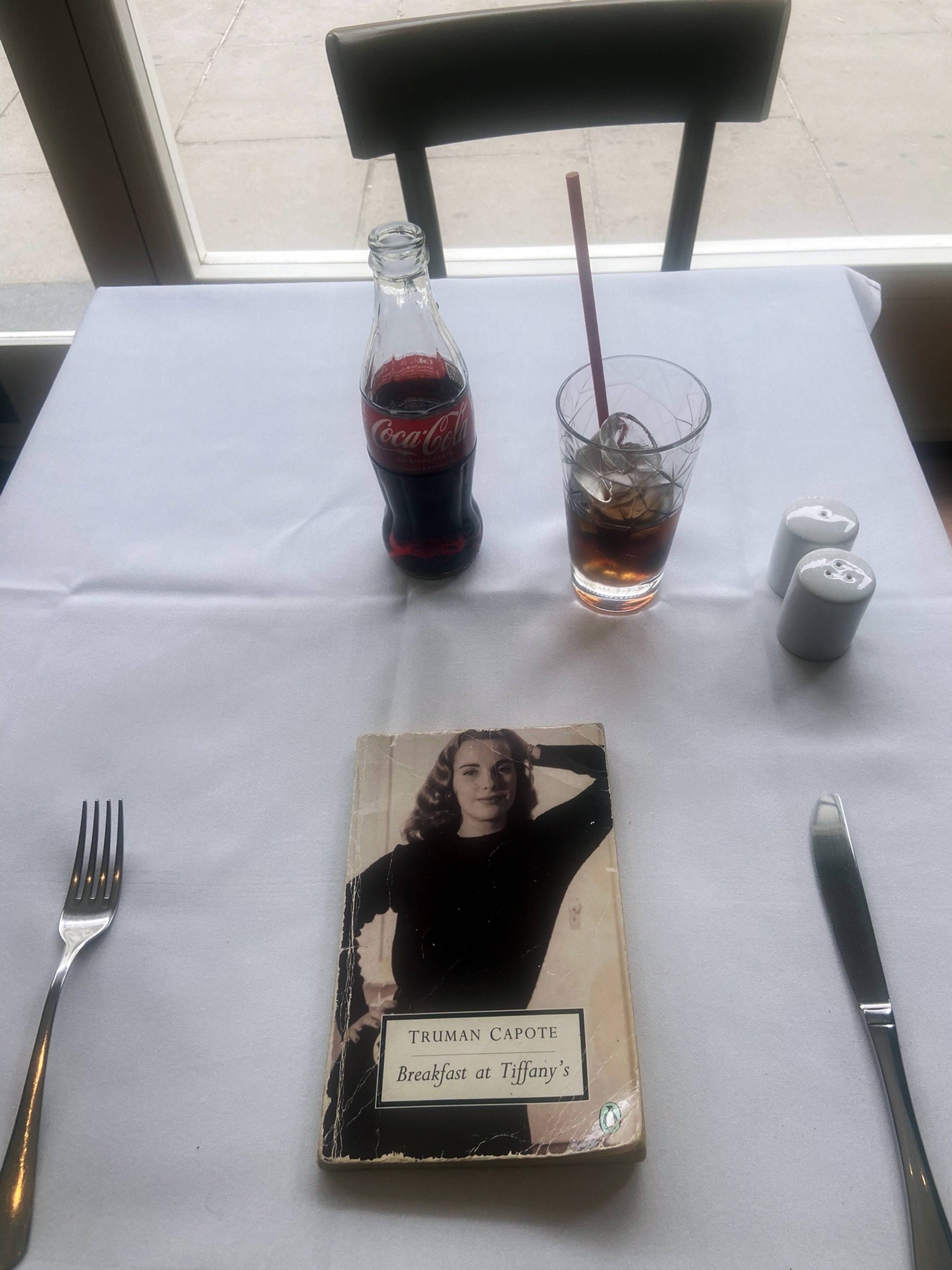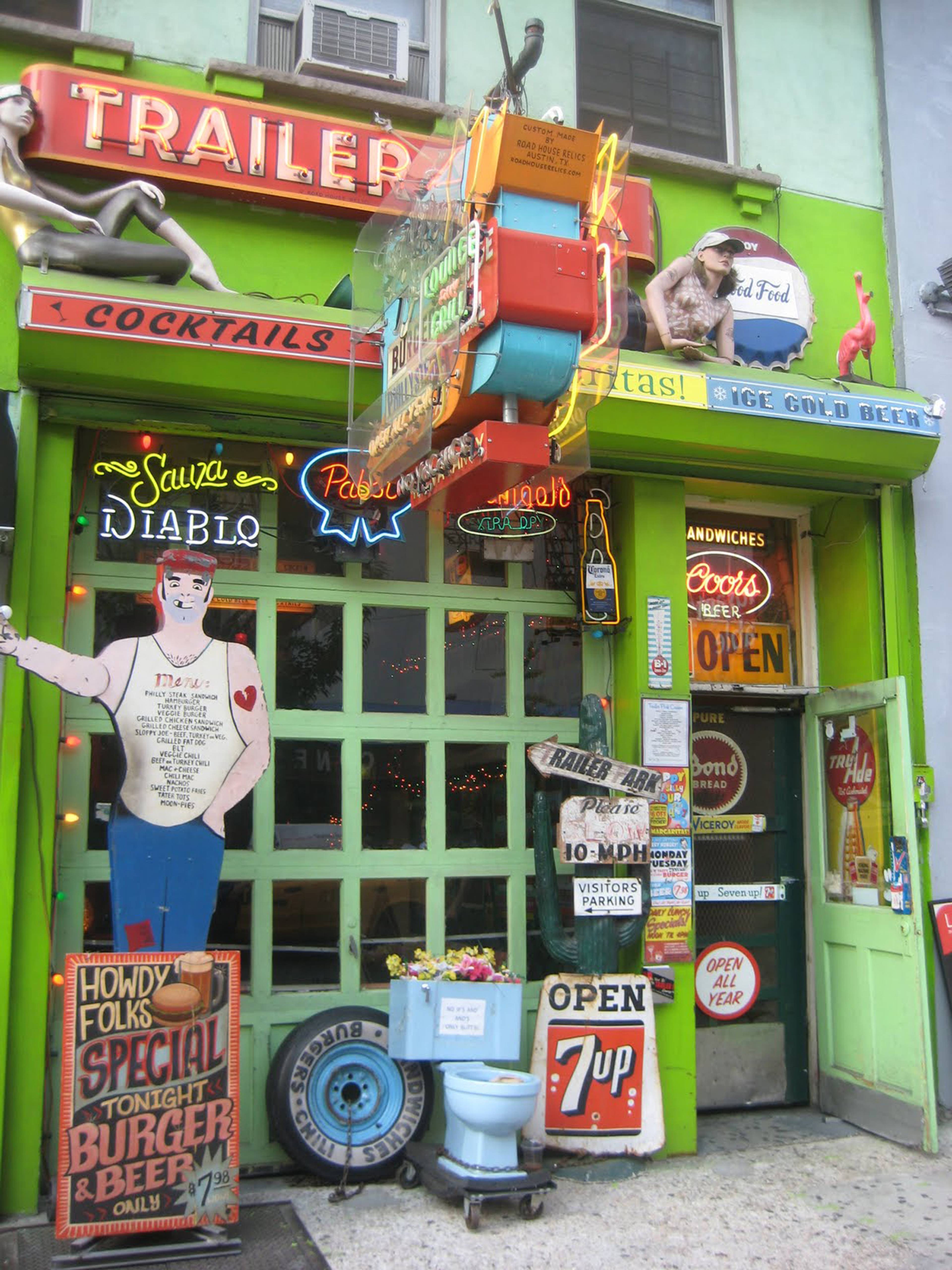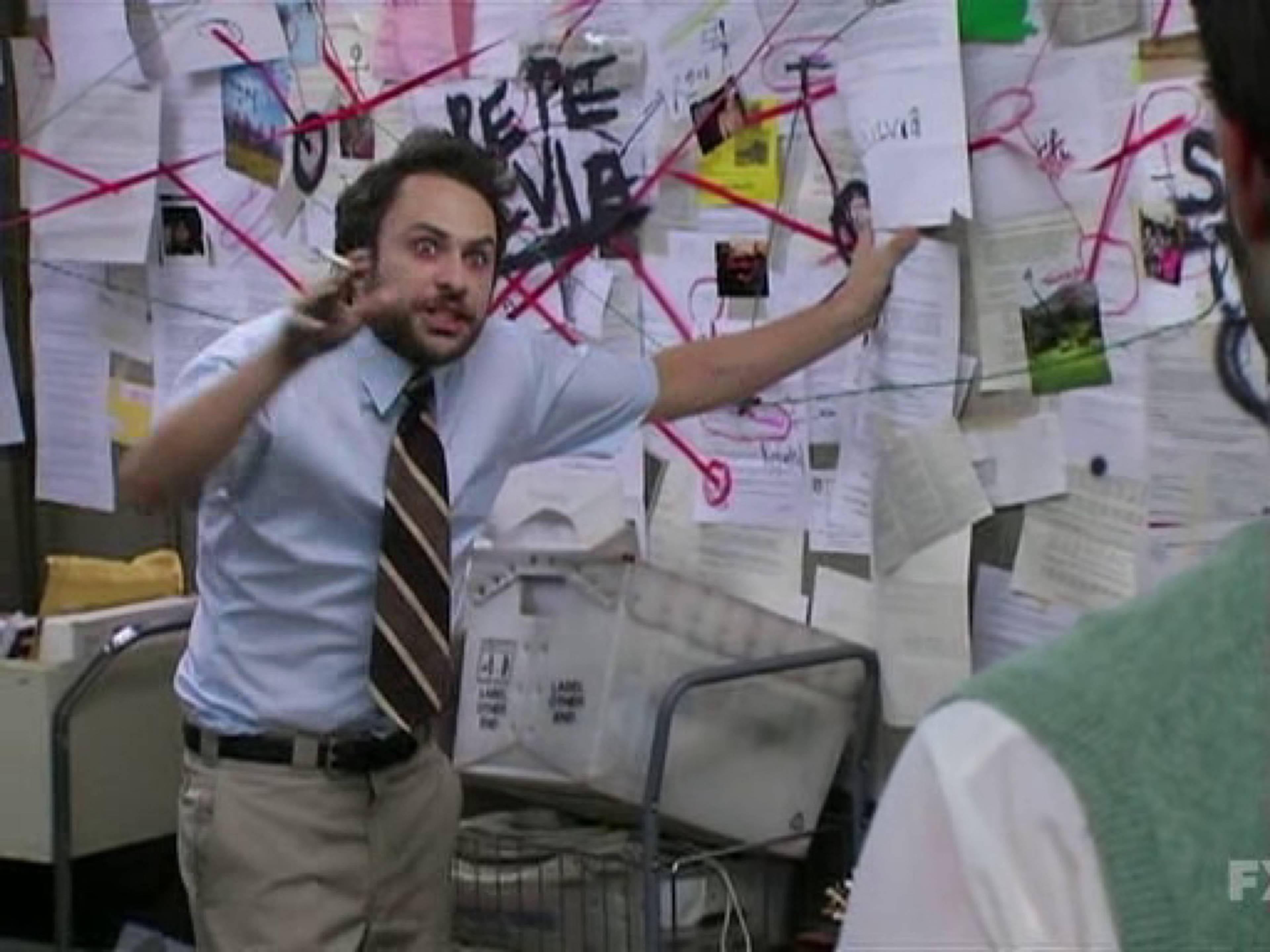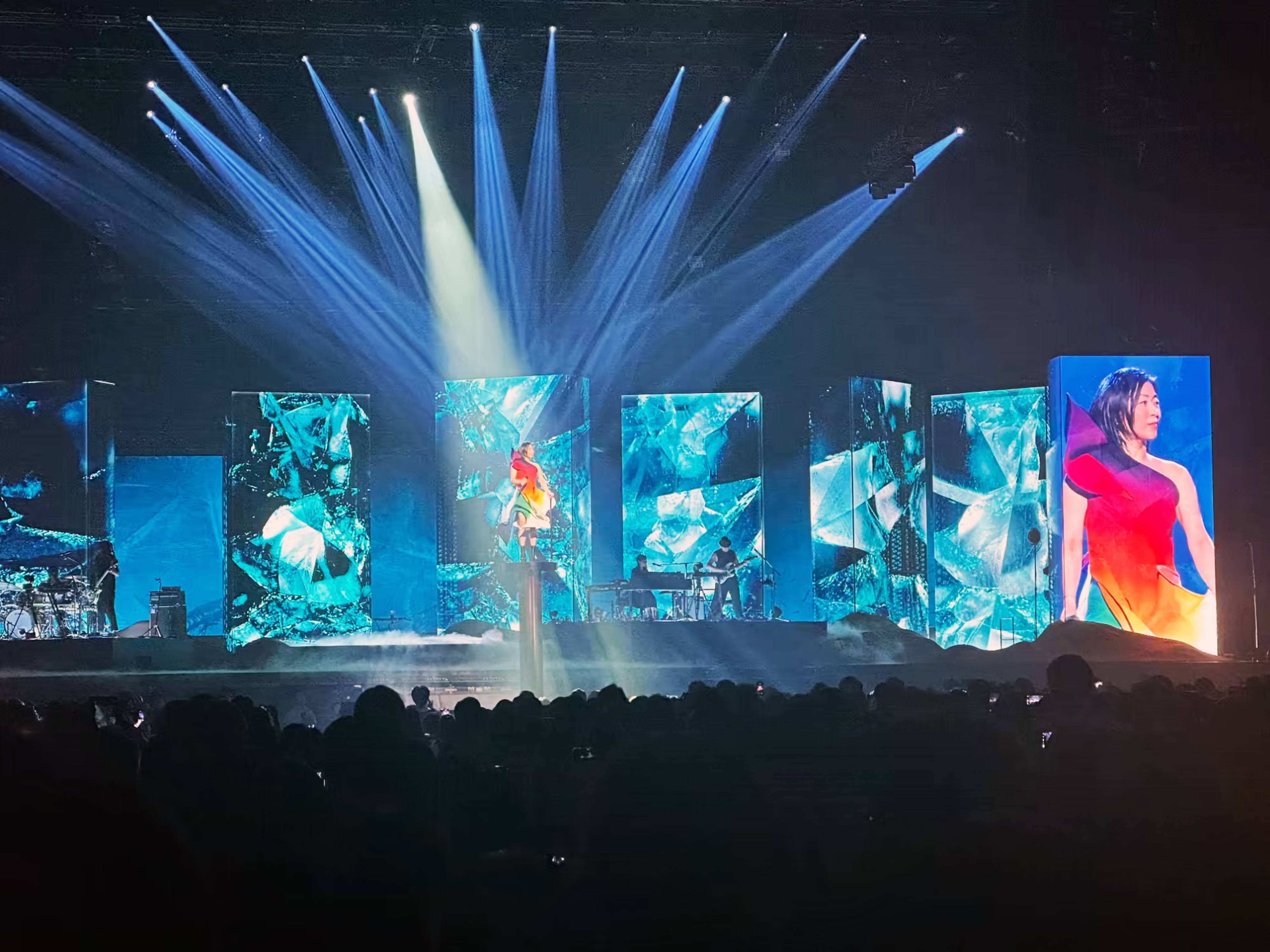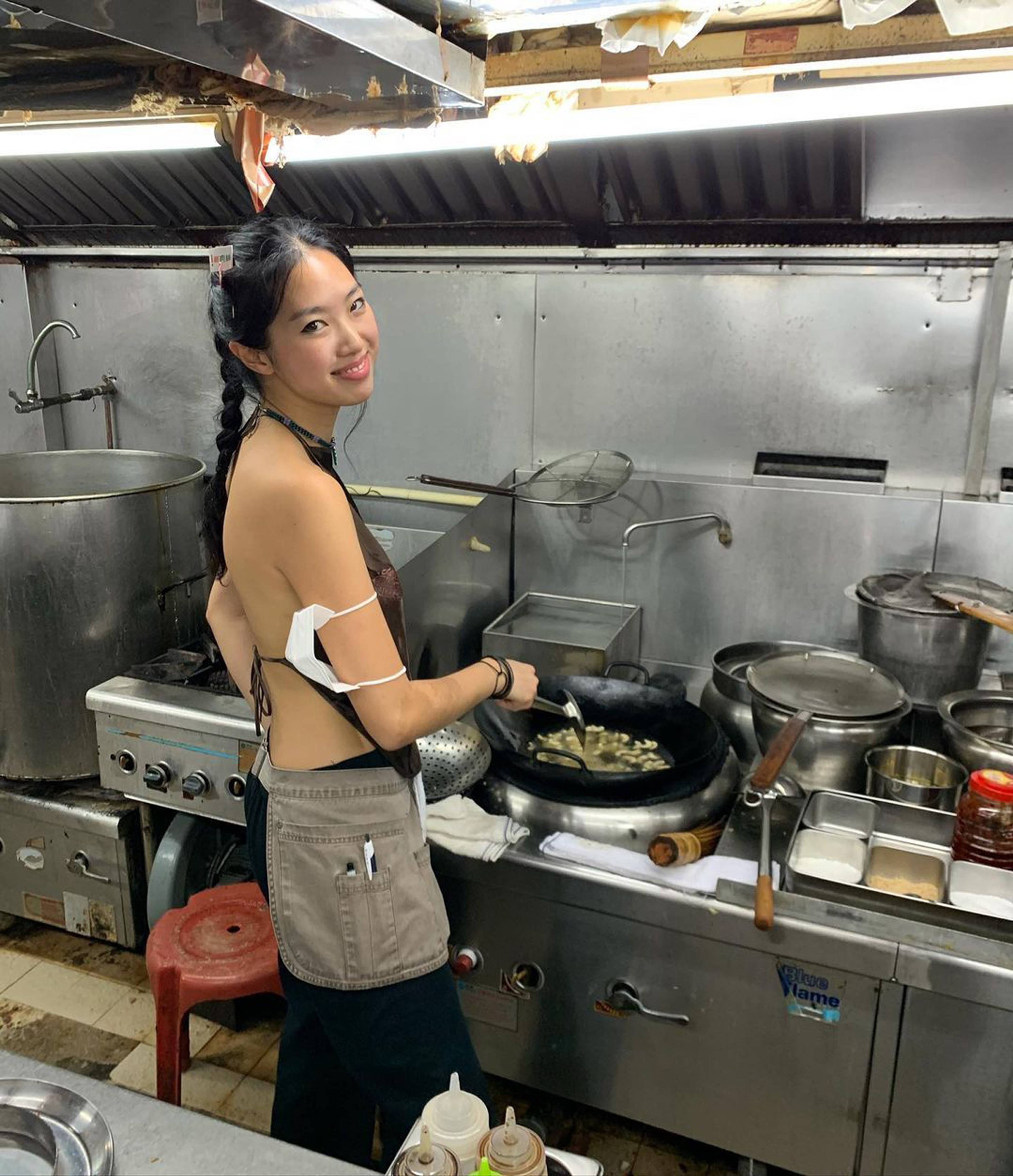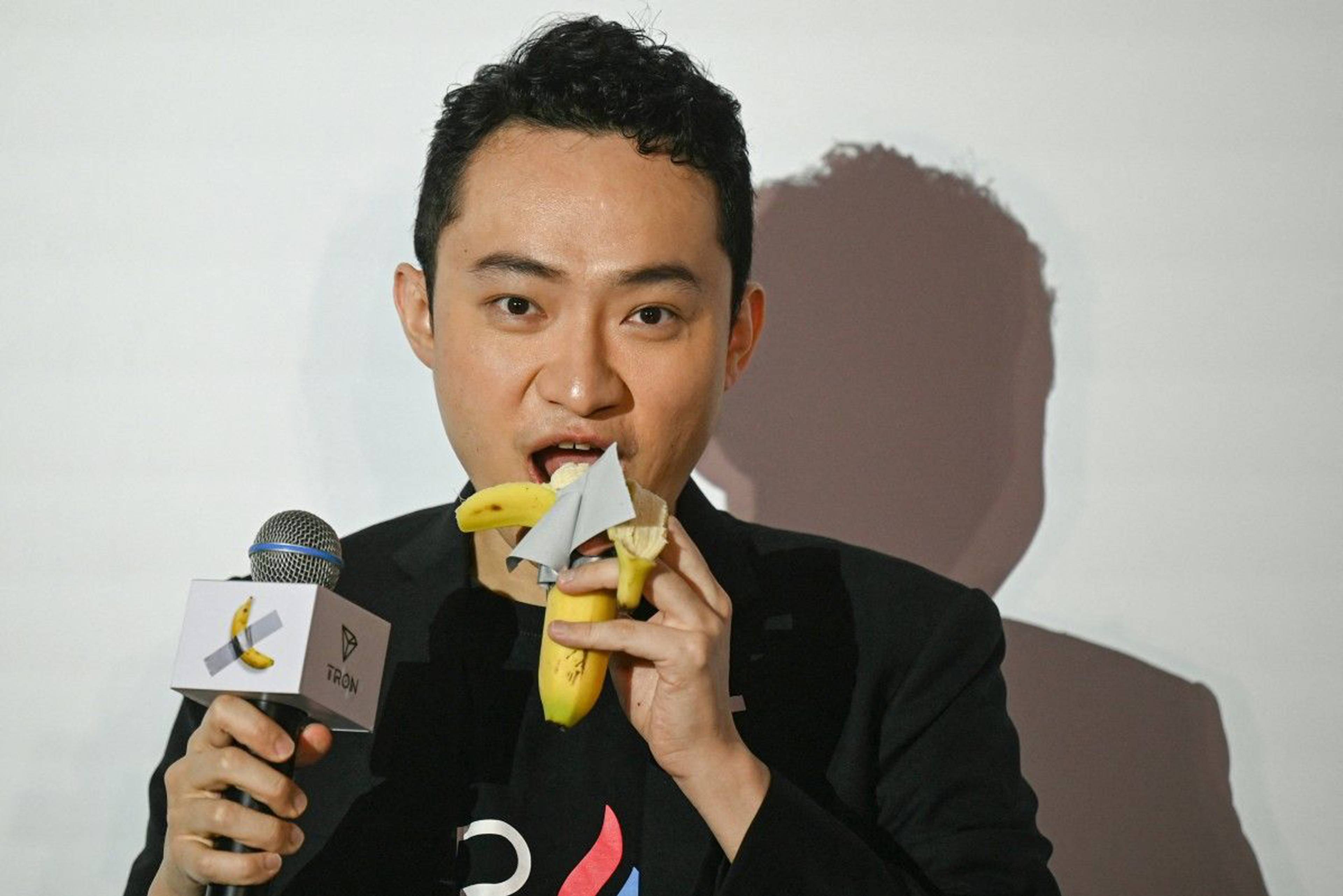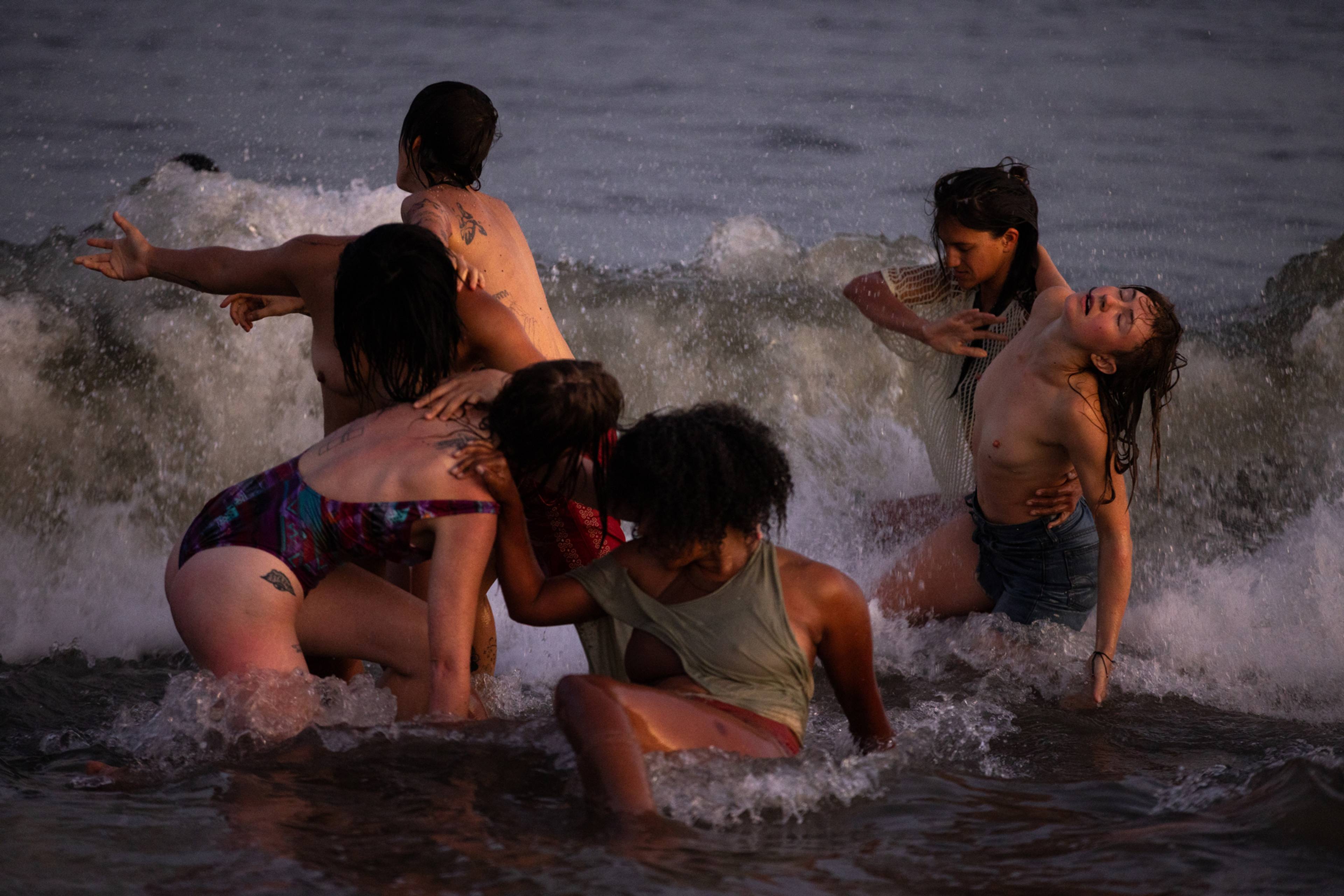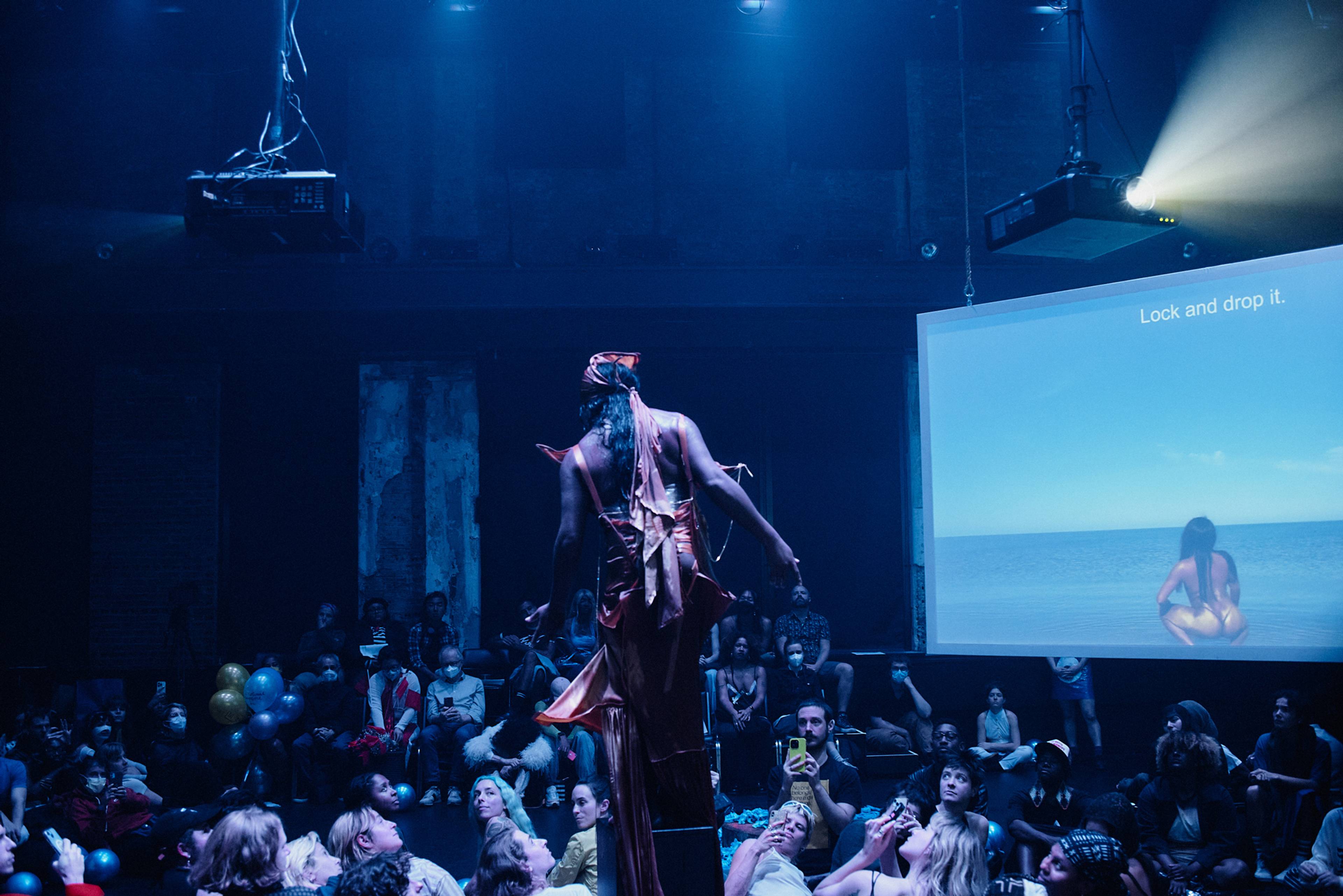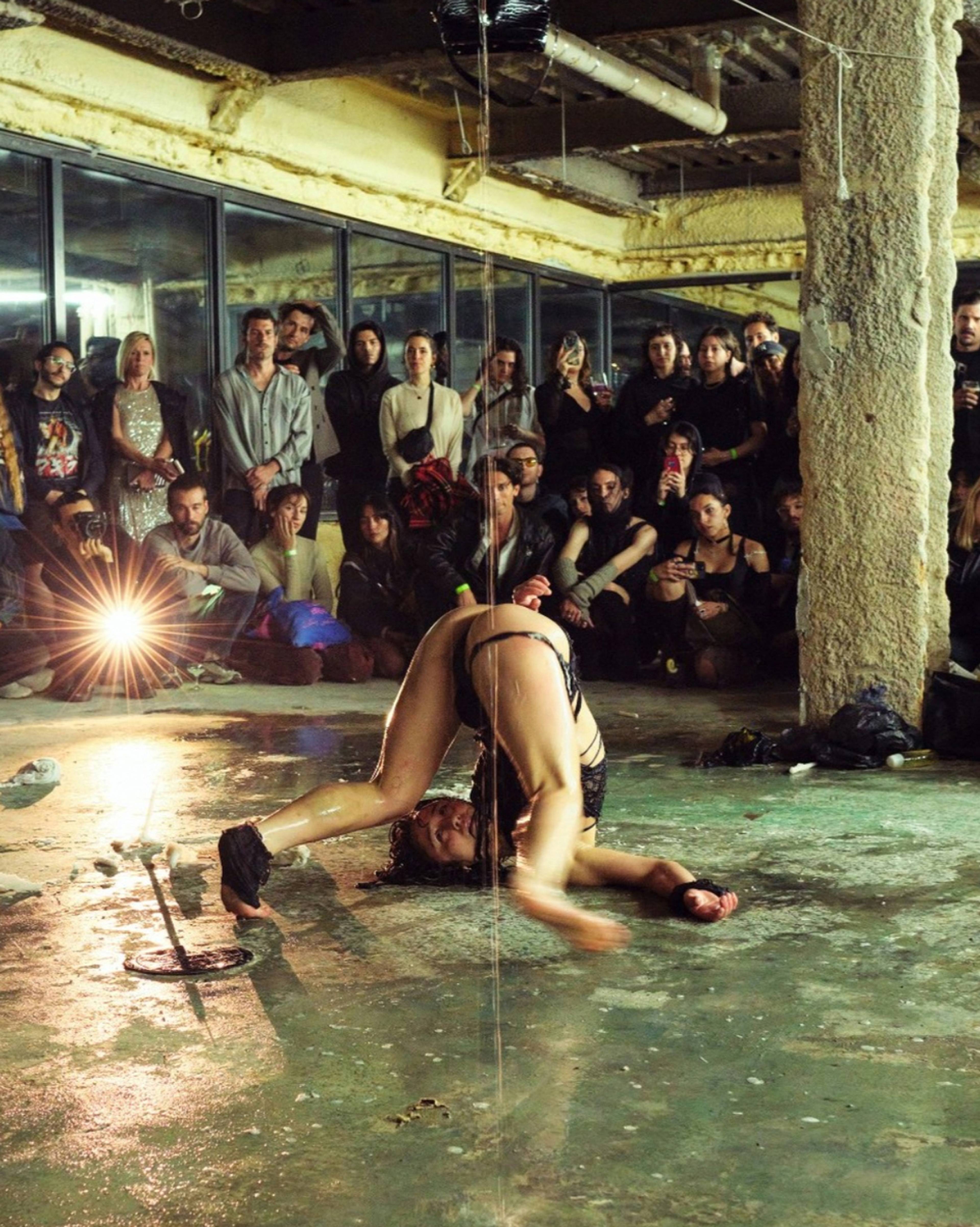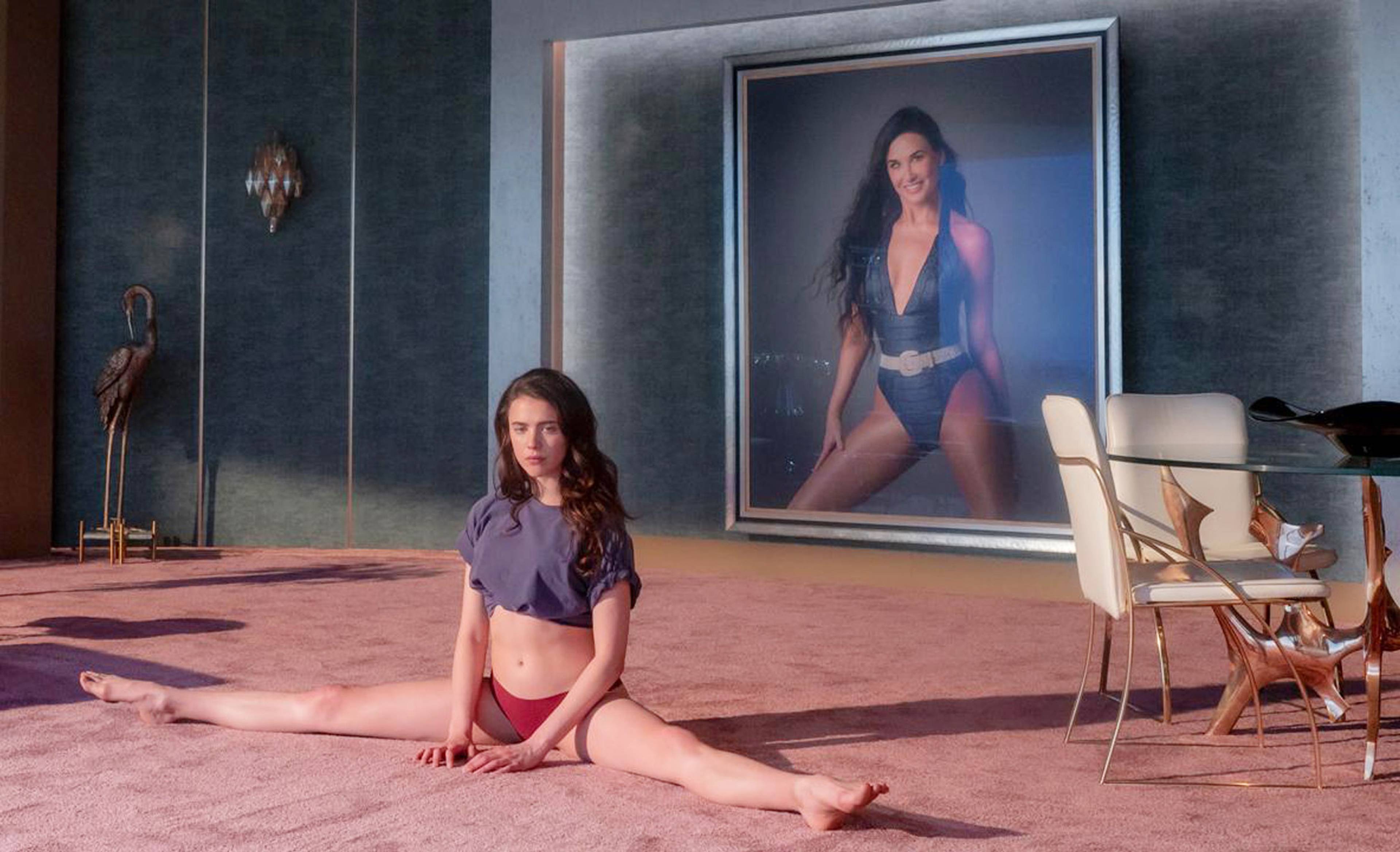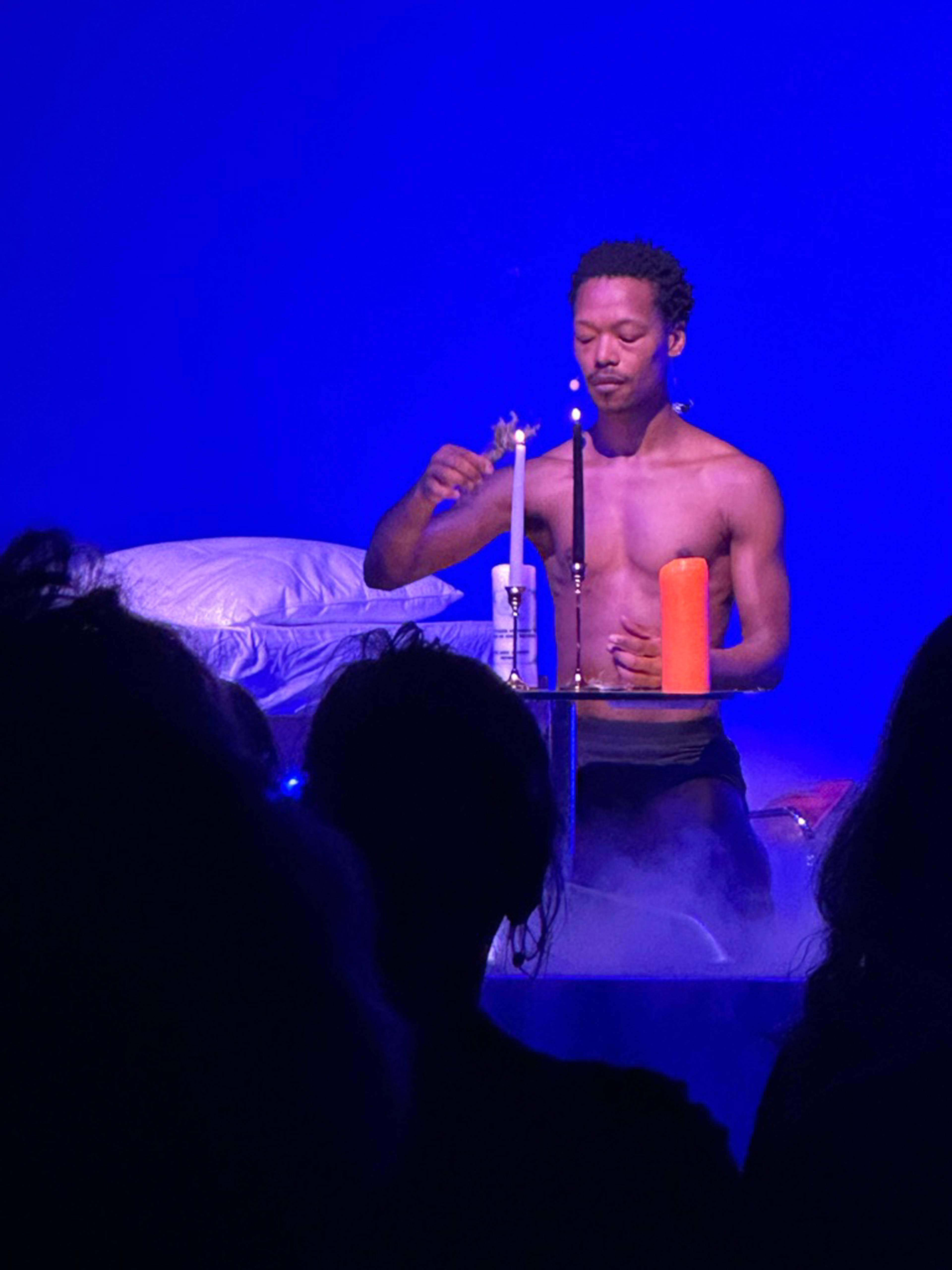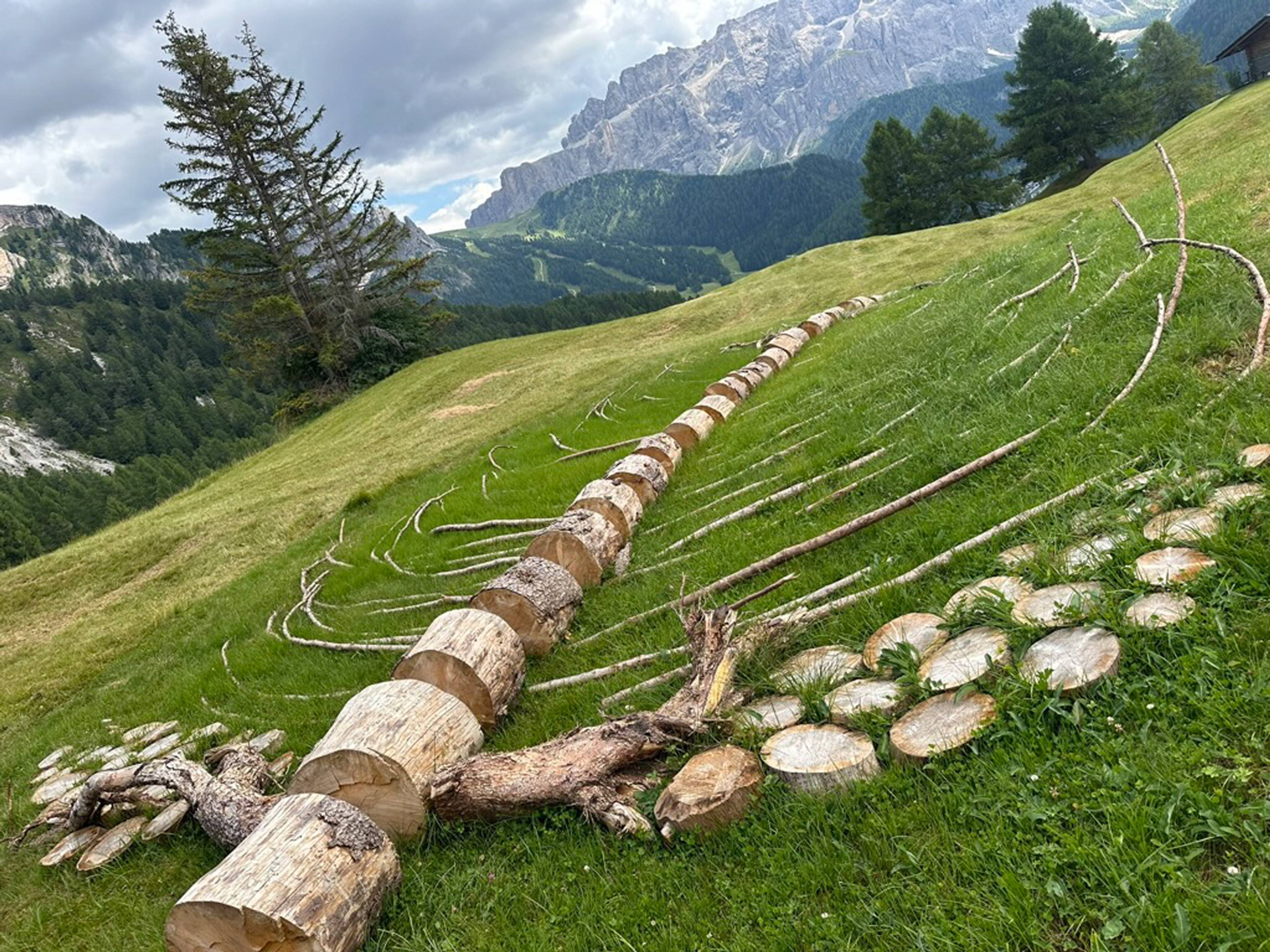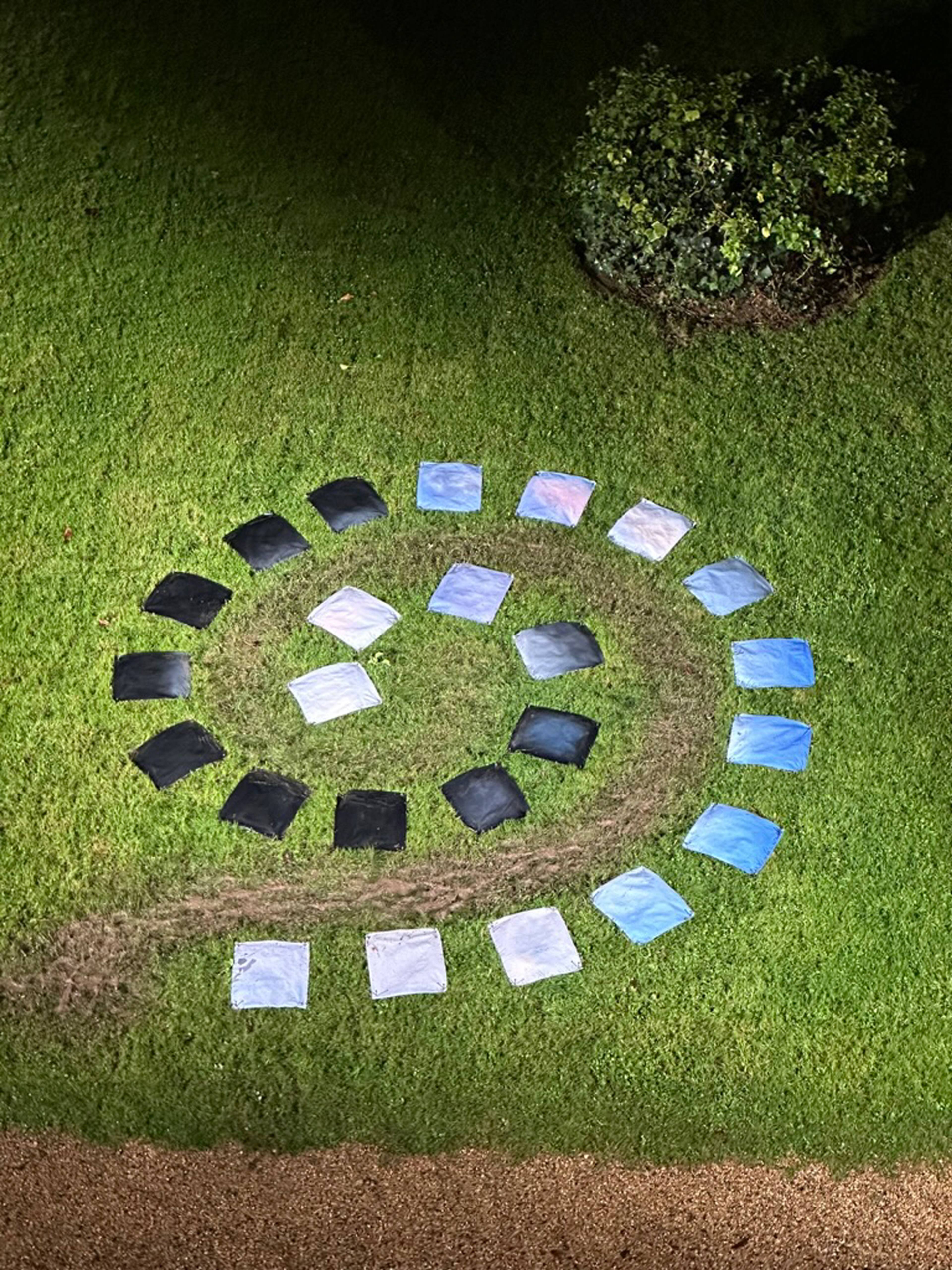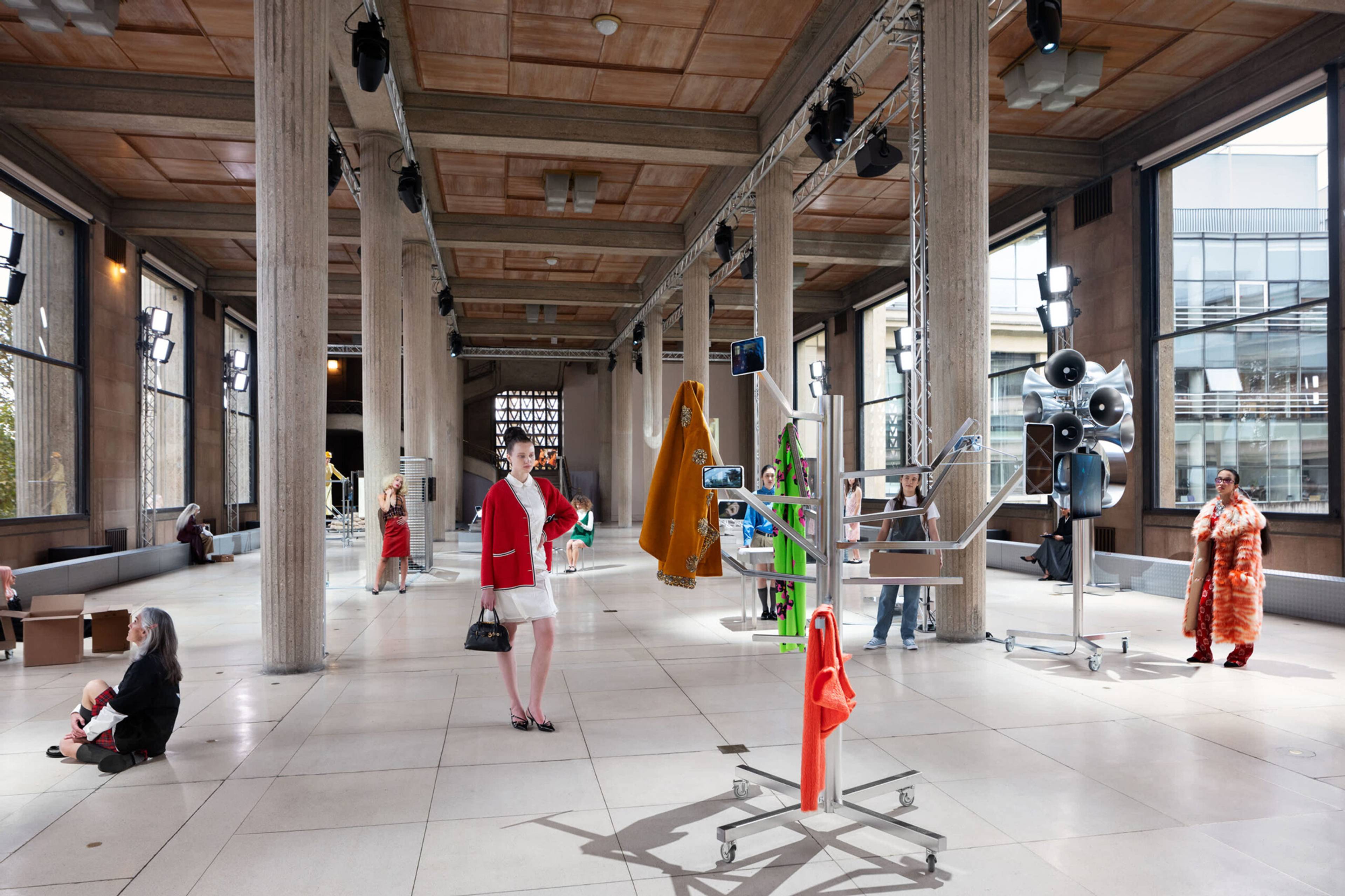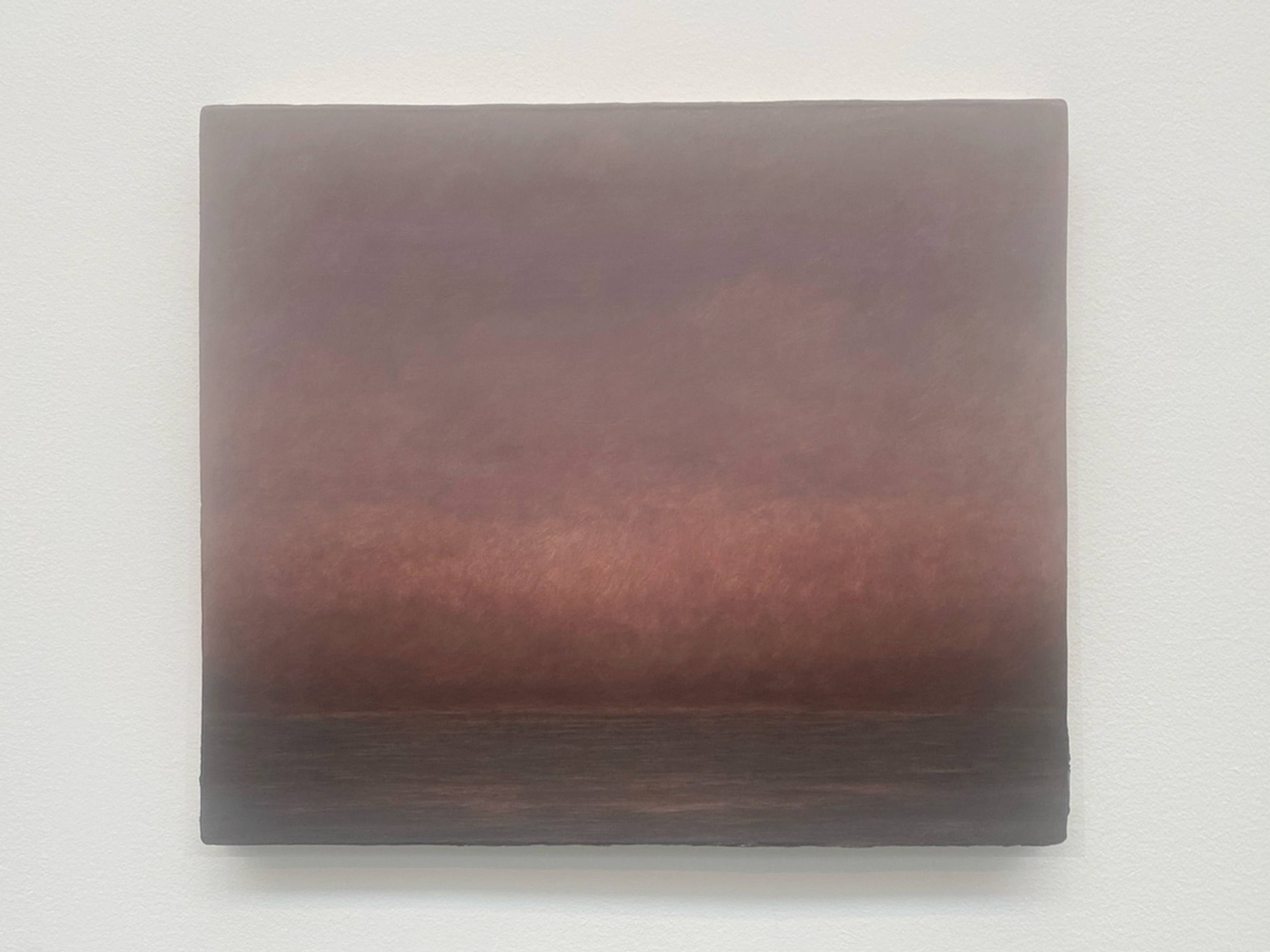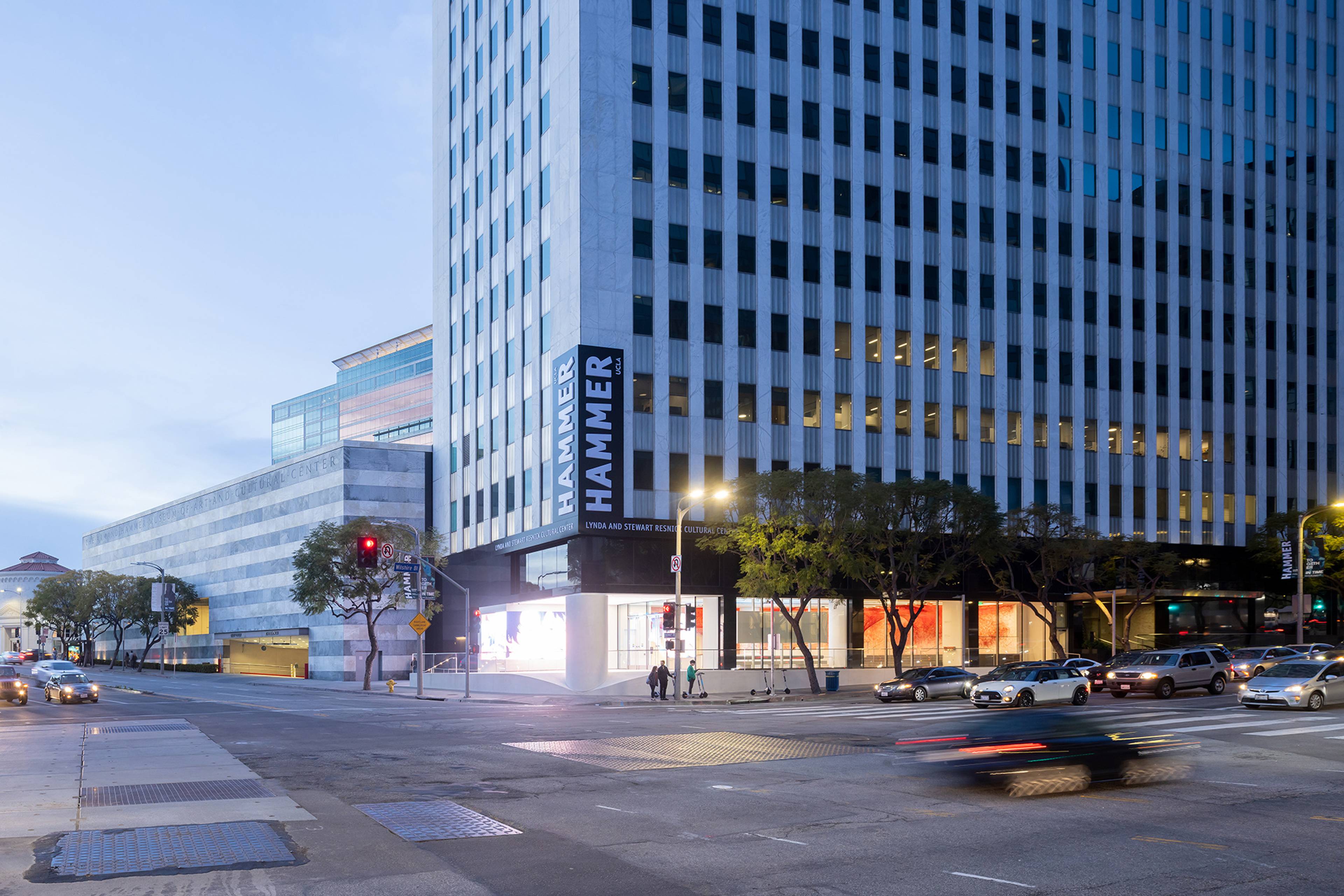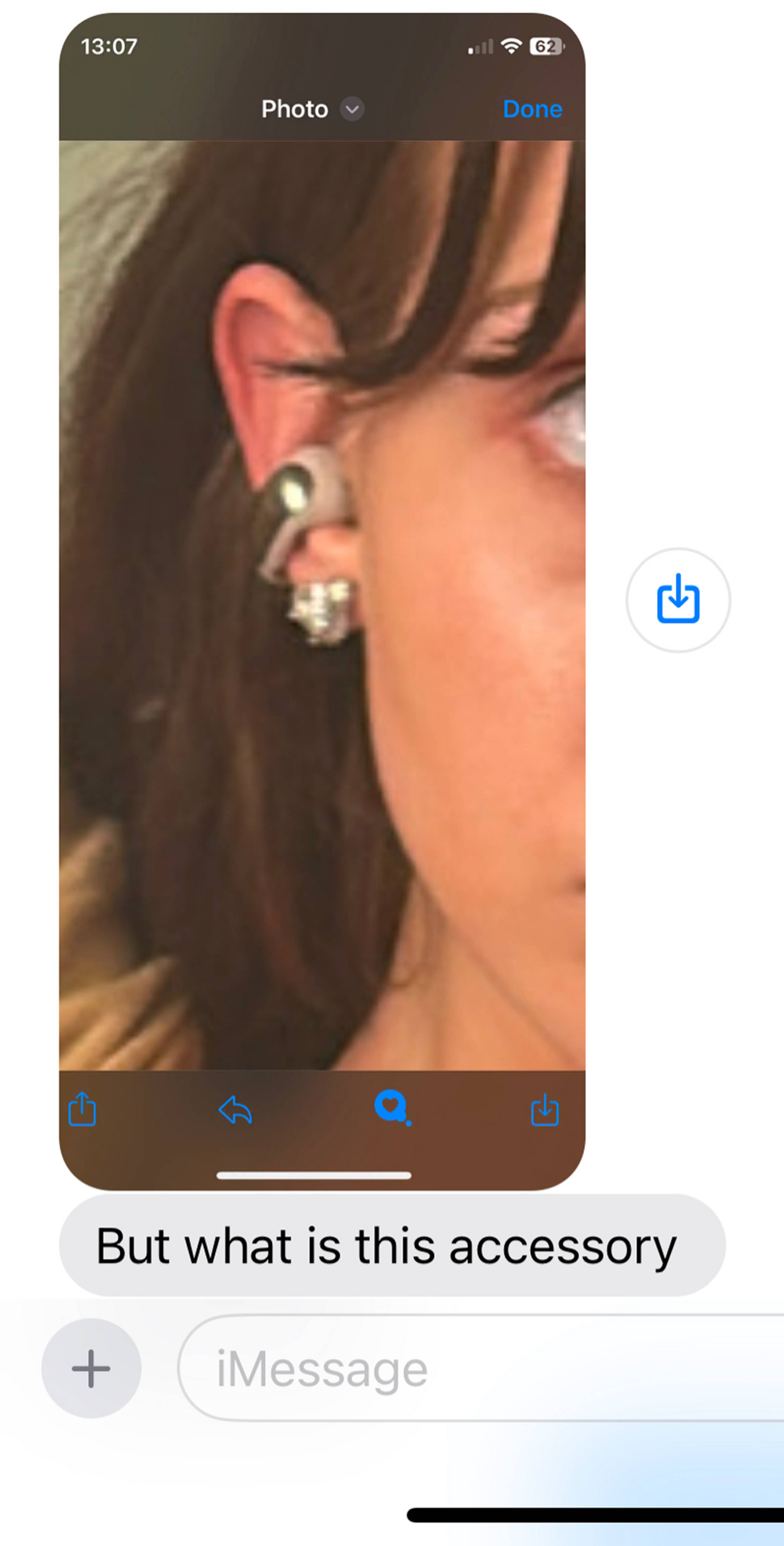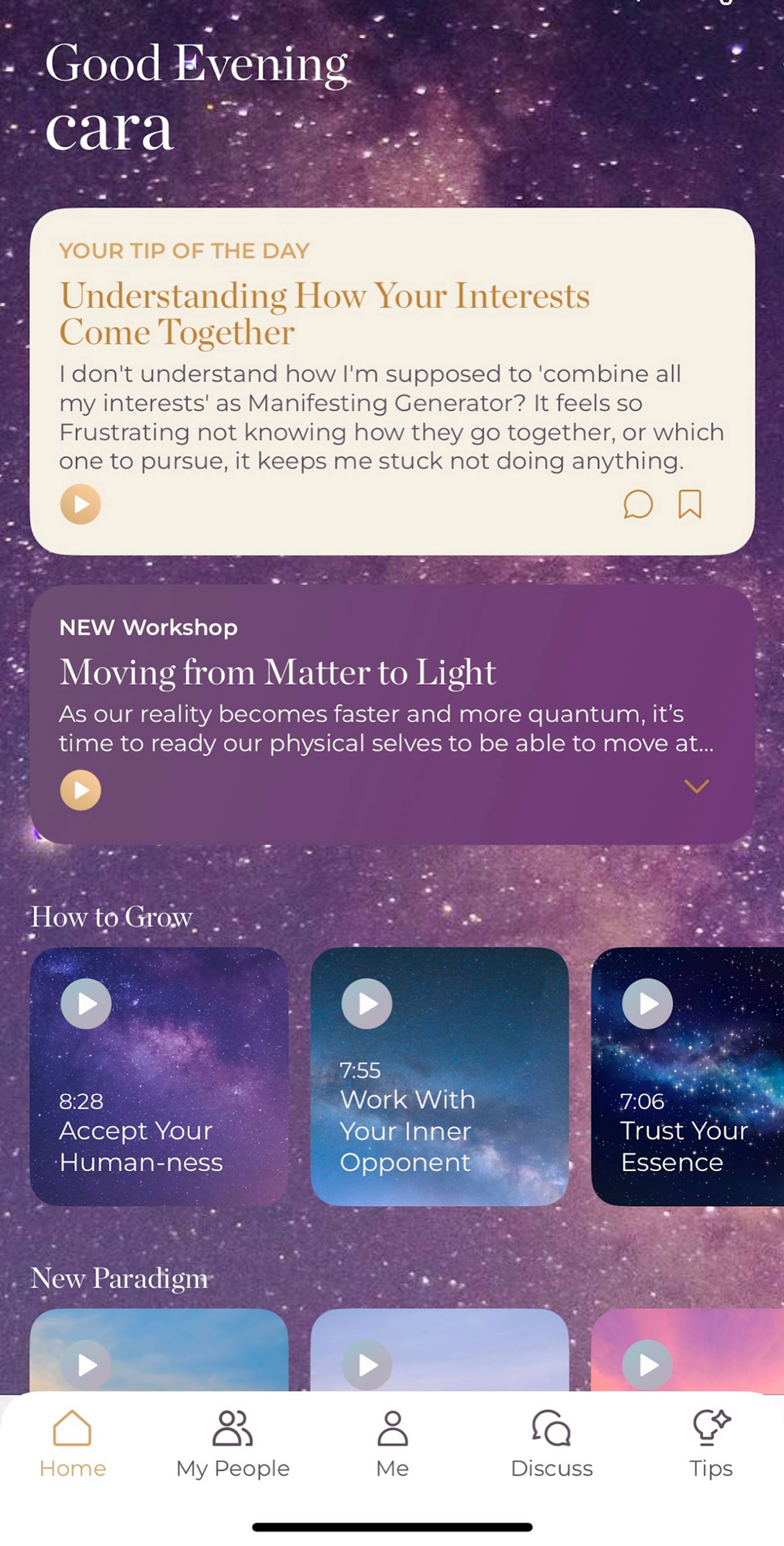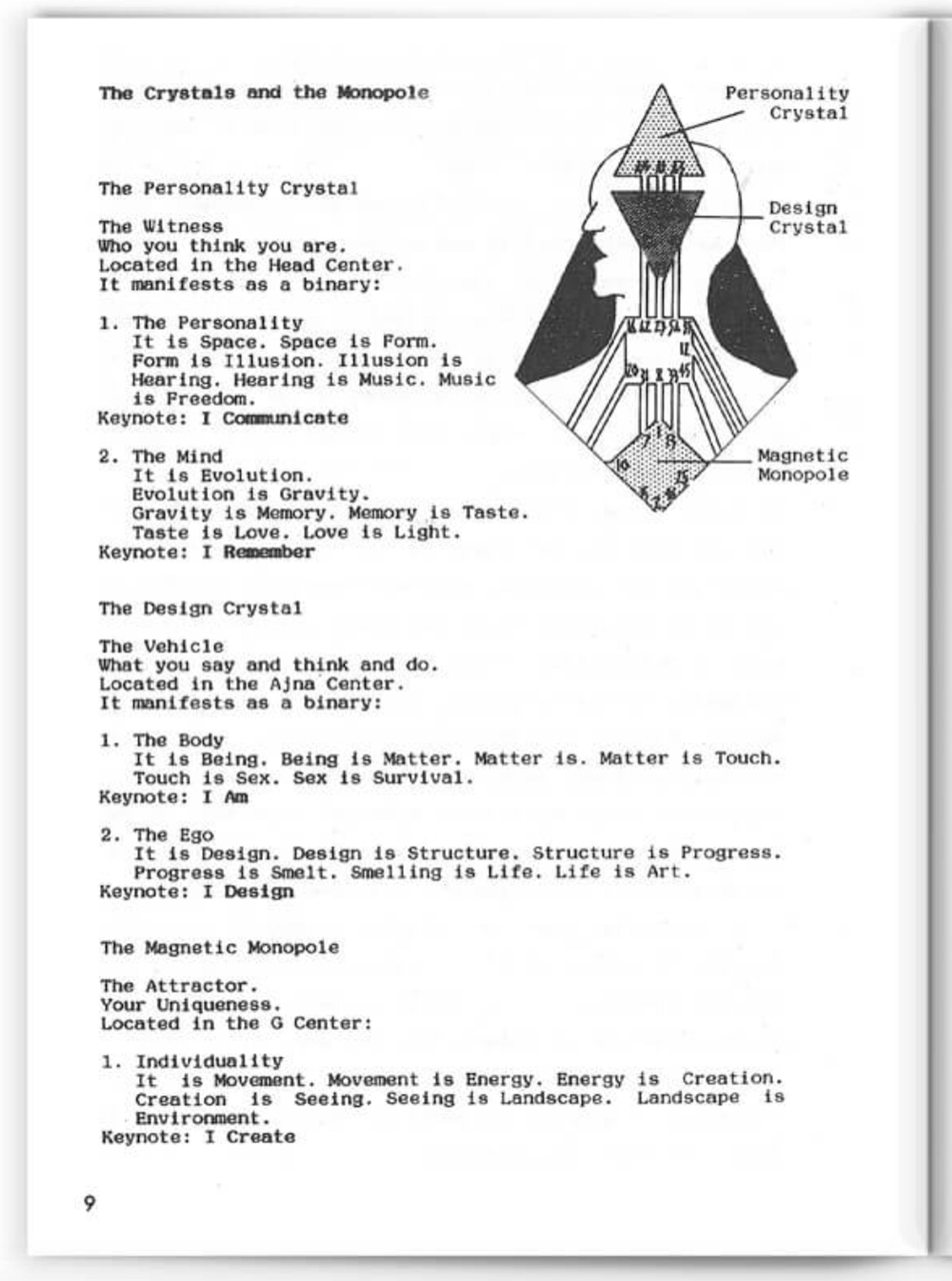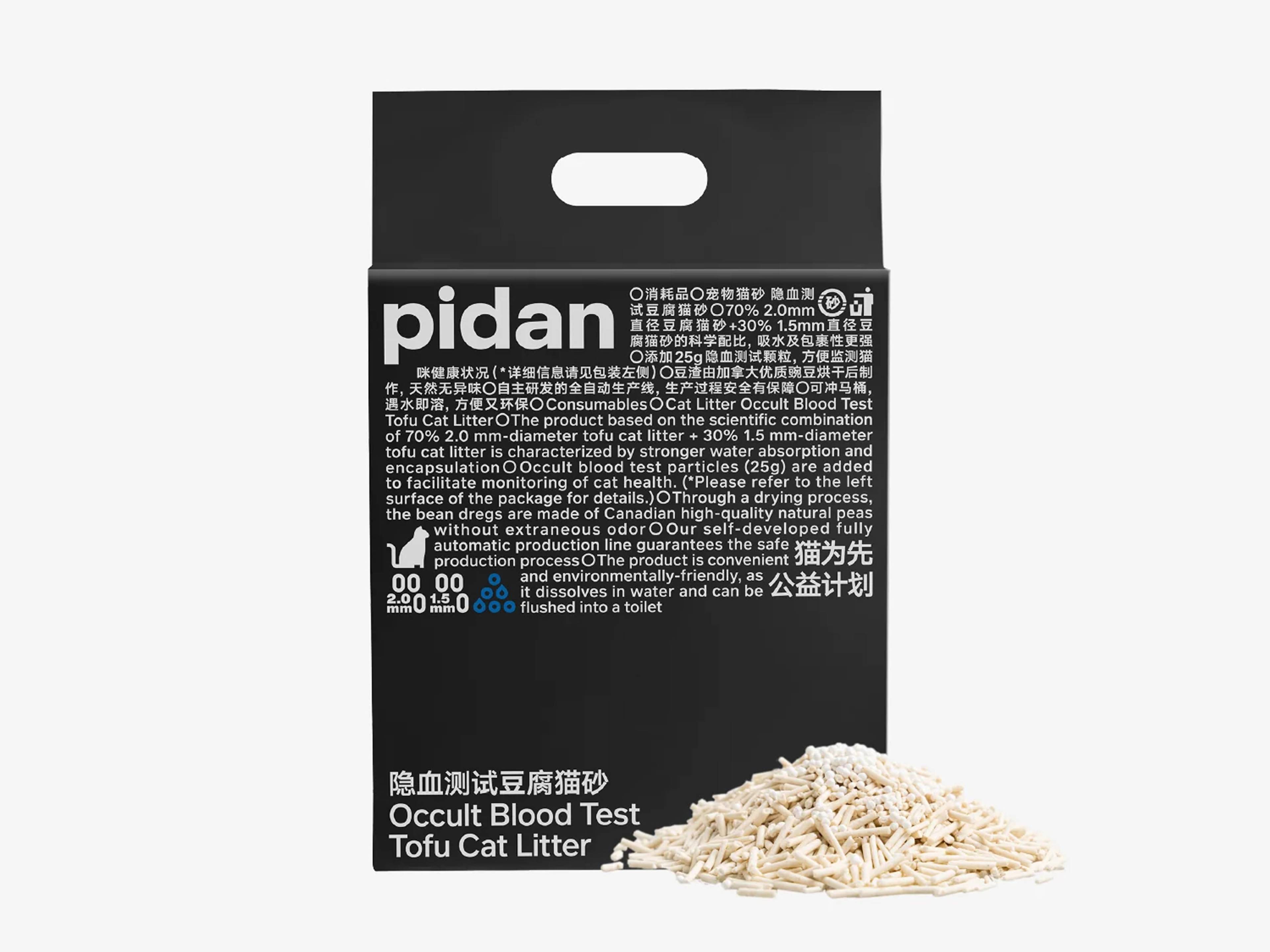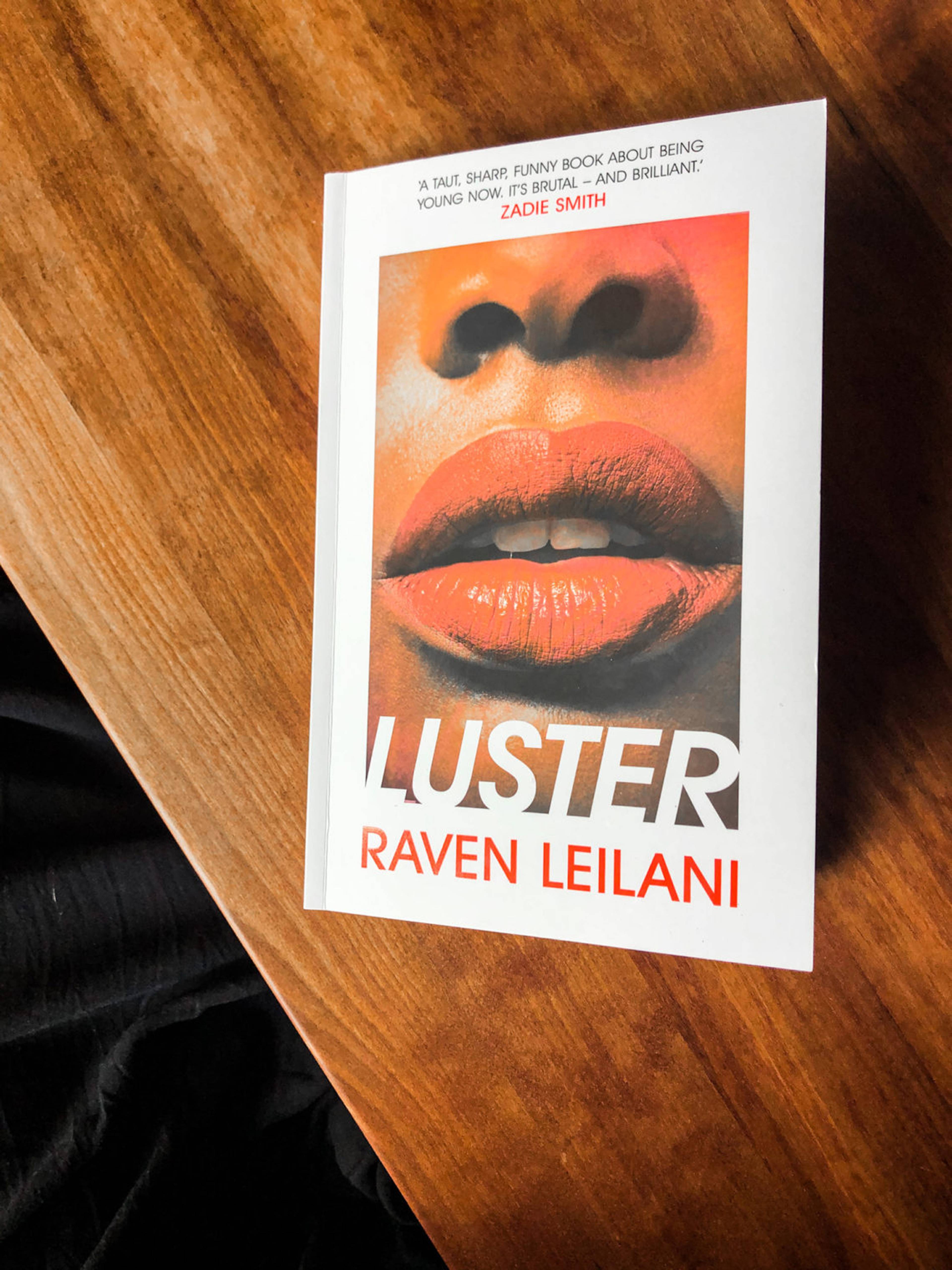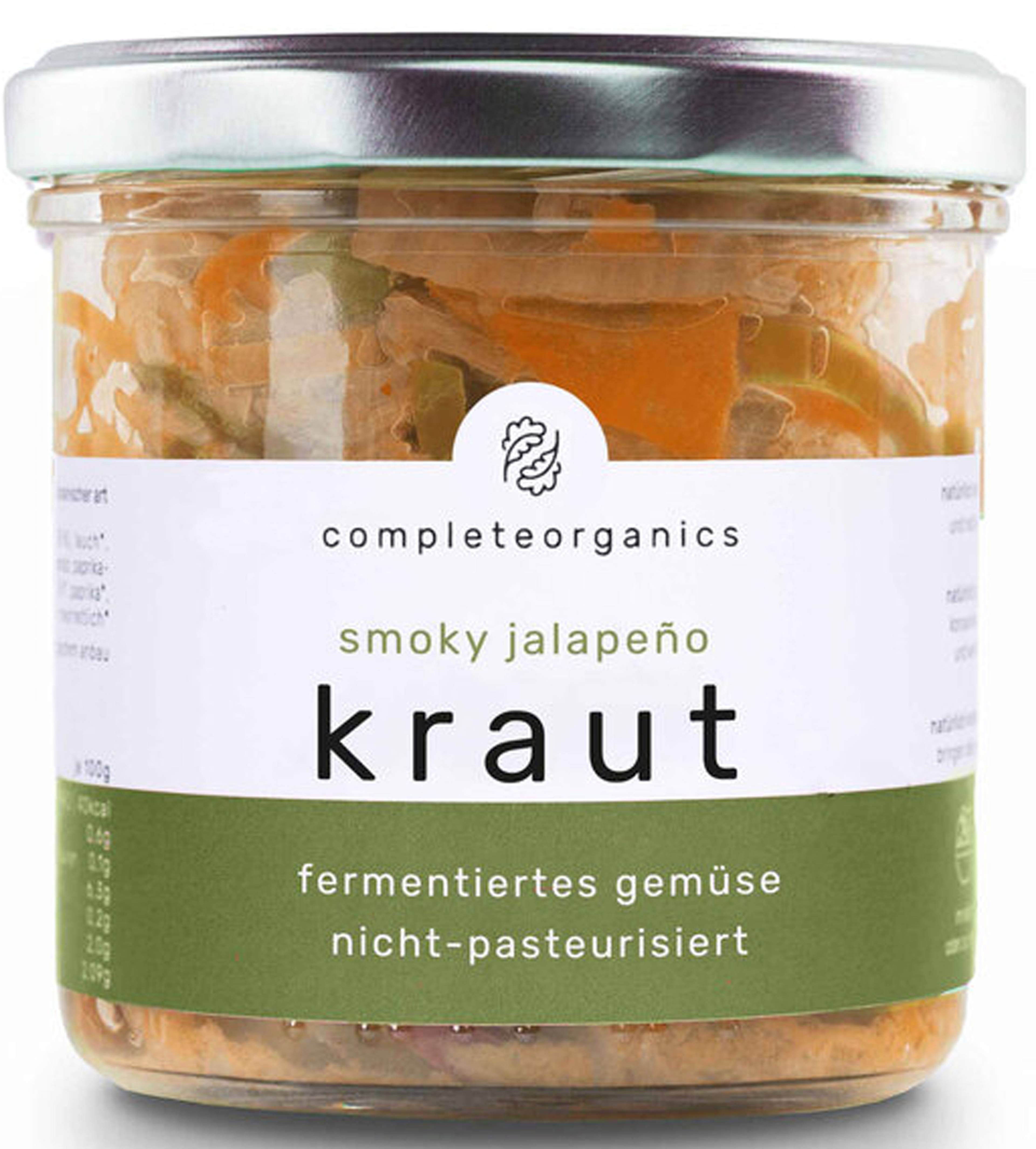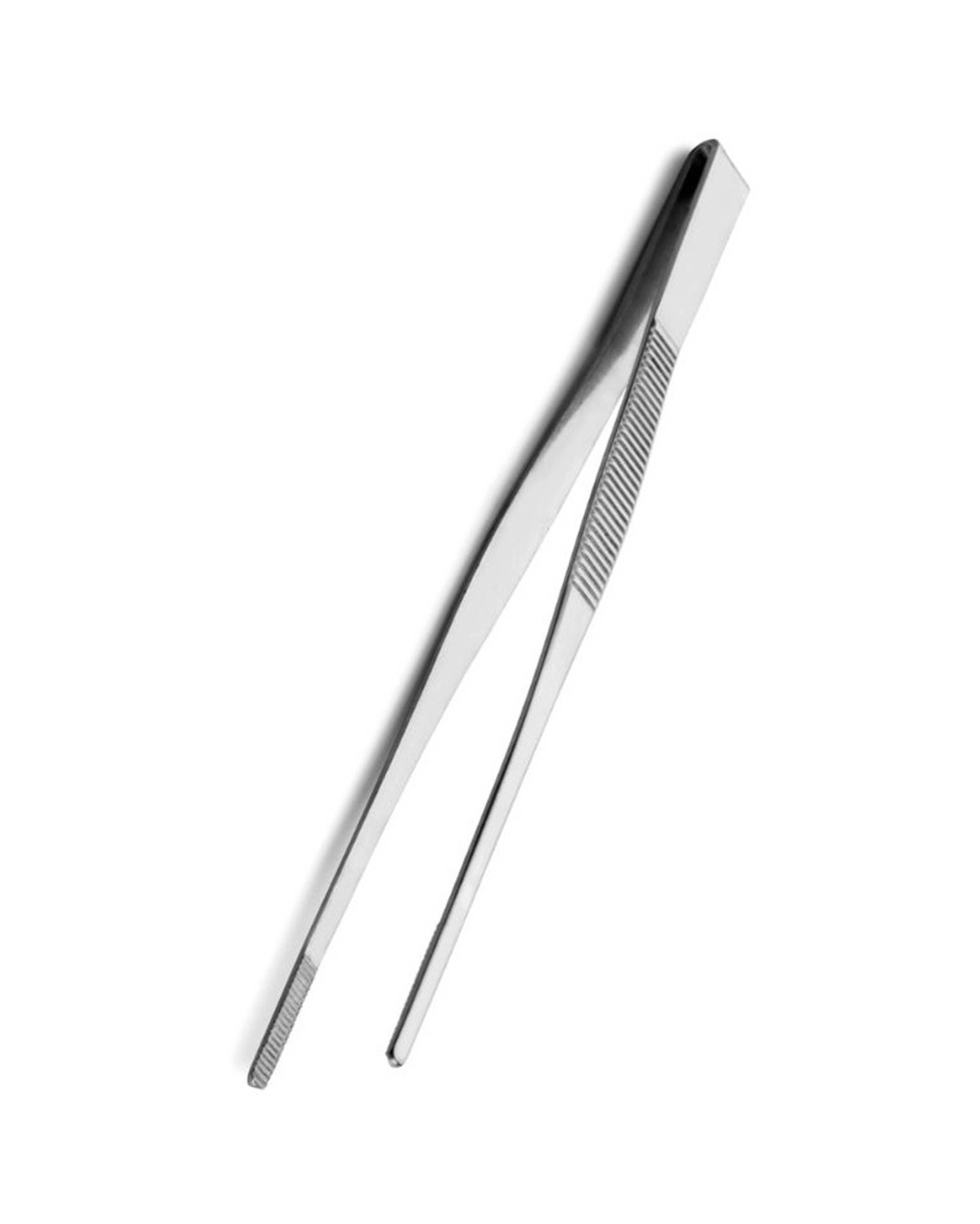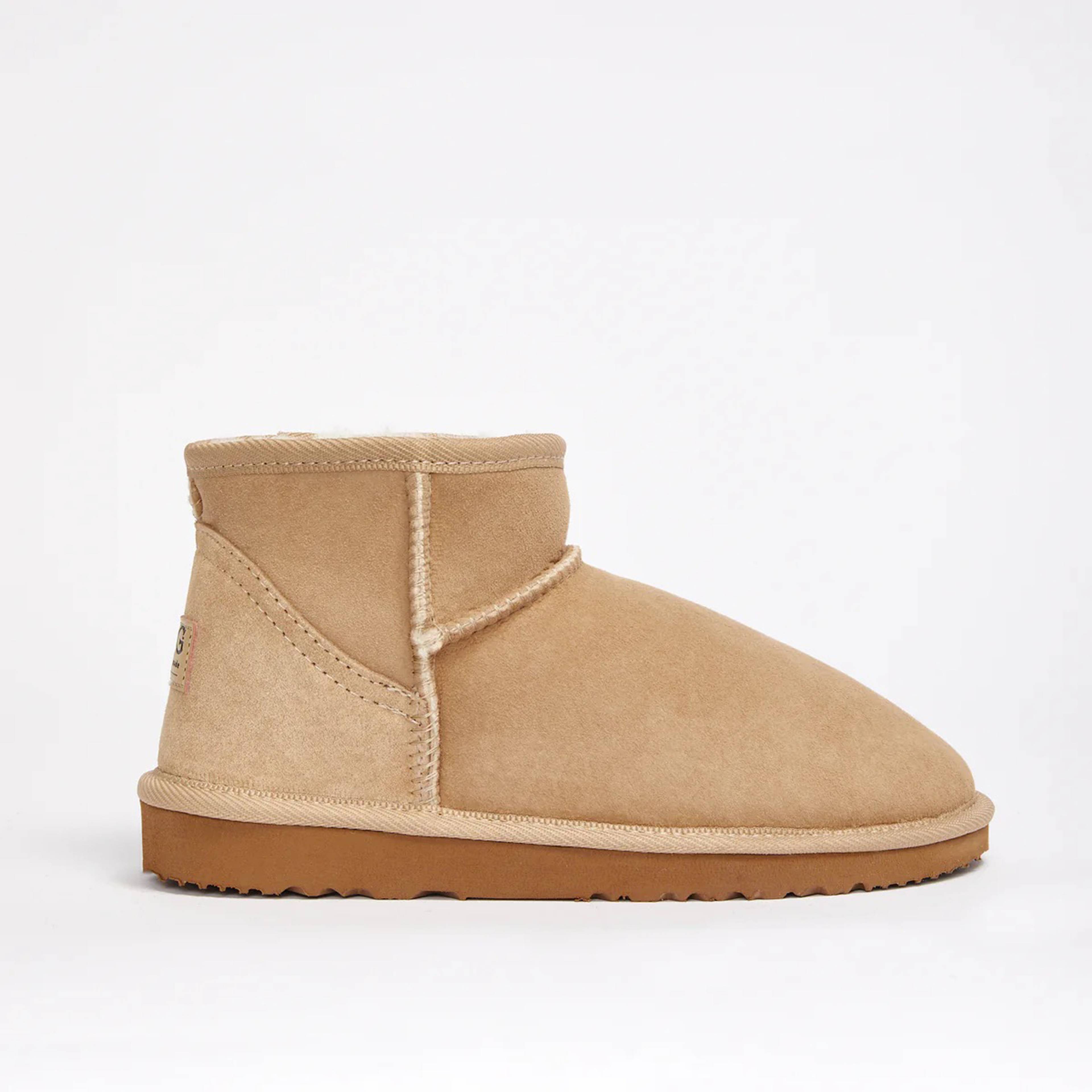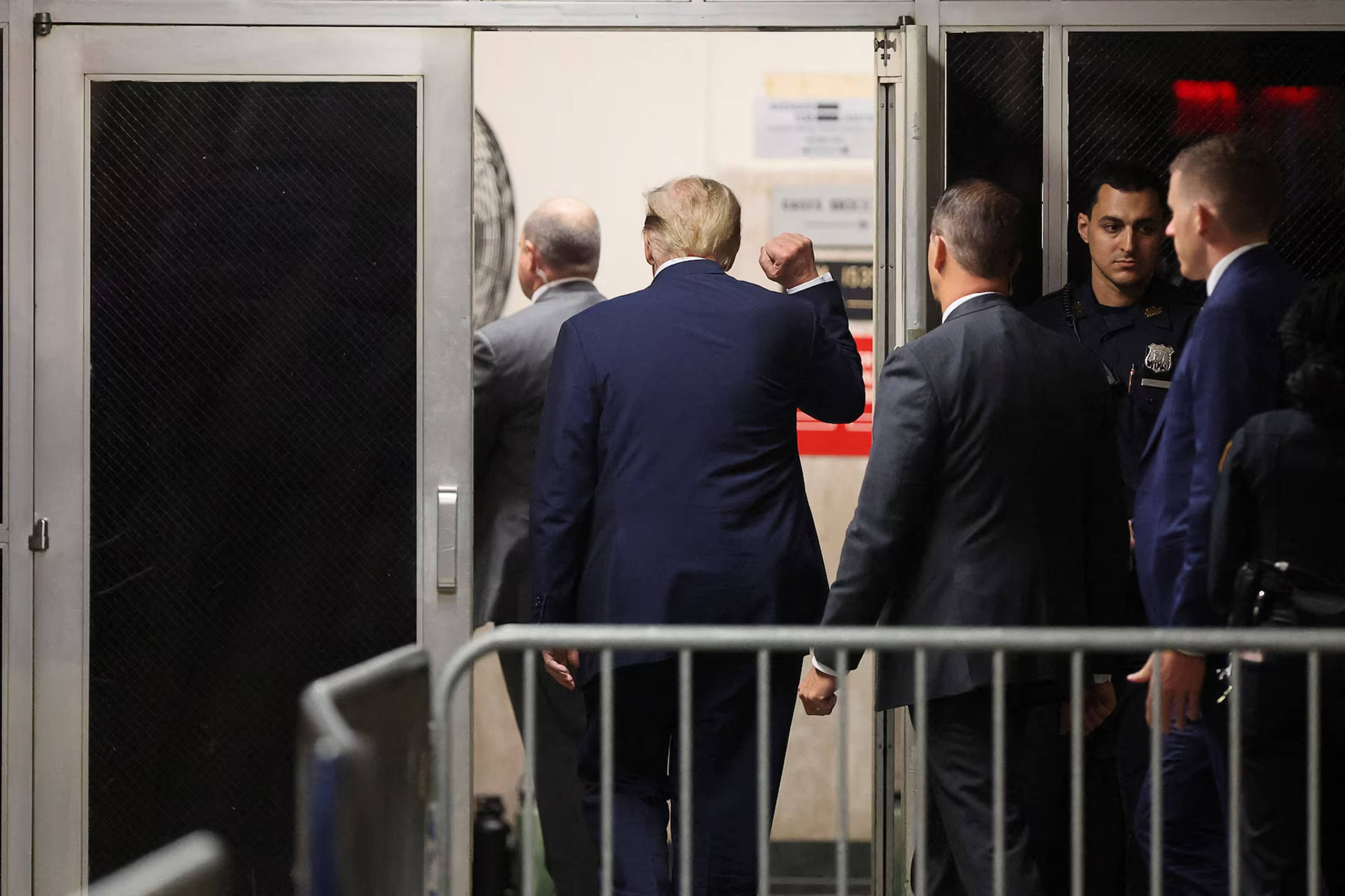SIMON DENNY – artist, Berlin
👍 “Haircuts,” Galerie Yeche Lange, New York
Earl, Negative Oil / Cuckfella, 2024, 216 x 152 cm, oil and paper on canvas
The artist Jared Madere has put together one of the most compelling and fresh new gallery spaces in New York’s Financial District (appropriately in a suite in the iconic 11 Broadway building, directly in front of the “bull” sculpture). Together with Wretched Worm, Supermetal Bosch, editor Anastasios Karnazes, and developer Miles Peyton, the office-gallery beautifully frames a group of artists who are as relaxed releasing Solana memecoins as they are making paintings or shitposting on X under pseudonyms. Their first exhibition in the space, “Haircuts,” this past summer staged a cohesive group of artworks from artists core to the program, including works by Madere and Worm. “Haircuts” felt like a truly 2024 take on where some punky energy is in play, in both crypto art and post-AI painting. Looking forward to more baroque grotesque, both off- and on-chain, in 2025.
👍 Christoph Büchel, “Monte di Pietà,” Fondazione Prada, Venice
Christoph Büchel, “Monte di Pietà,” Fondazione Prada, Venice, 2024. Photo: Marco Cappelletti. Courtesy: Fondazione Prada
Christoph Büchel, “Monte di Pietà,” Fondazione Prada, Venice, 2024. Photo: Marco Cappelletti. Courtesy: Fondazione Prada
The Swiss artist/provocateur Christoph Büchel staged one of the most dense, richly crafted exhibitions addressing a kind of canon of value-trickery in art that I’ve ever seen – camouflaging many financial-art masterpieces from Yves Klein to Mitchell Chan and many Jamie Dimons in-between actual trash, museum items, and meaning-laden bric-a-brac. Aside from being so detailed, literate, and enjoyable to experience, with television shows (art and not), TikTok channels, and historical archives literally piled on top of themed rooms and faux-water-damaged walls, this exhibition also included one of the most interesting attempts by a contemporary artist at a crypto artwork that isn’t an NFT.
Alongside the show’s release, a cryptocurrency, “Schei,” was launched (ticker $SDM, contract address 0xE1db8391debE15204F41701c476e5d659F87660D), named after TikTok “granfluencer” Regina de Schei of Venice, which is “dedicated to the notion of debt as the base of society.” Incredibly designed as a deflationary currency, losing 1% of supply with every transaction, its largest holder is obliged to systematically burn her holdings in “direct correlation with the rate of decline of the population of Venice.” It was free to claim during the exhibition. There are currently only sixteen holders of the currency, which has now become un-mintable (and therefore playfully scarce). Vibing along with other 2024 artist memecoin projects like $OMG, minted by Avery Singer and Matt Liston, Büchel’s show housed what I hope is a return to sophisticated artist conceptual work using crypto – a genre that has suffered a less-celebrated (and correspondingly less reviled) fate than collectible-adjacent NFT projects.
👍 THIS CURSED MACHINE by Moving Castles (Arthur Roing Baer, Alex Declino & Rasmus Svensson)
THIS CURSED MACHINE is, according to its own description, a “sci-fi body horror fulfillment-center simulator” – and one of the most original, fun crypto-based games to be released yet. Arthur Roing Baer’s other projects, like Trust – a collective and co-working space for “utopian conspiracists” – have been important connectors for tech-literate creative builders, in and out of art contexts in Berlin, for the last five years.
Screengrab from THIS CURSED MACHINE by Moving Castles
TCM and Moving Castles in general mark an important shift for Baer. Along with co-founding a web3 gaming studio in Kreuzberg, he and his collaborators (notably Rasmus Svensson of PWR Studio, responsible for many of the more engaging design efforts for PAN records and artists like Amnesia Scanner) are making use of the highly fundable market for crypto gaming. The result is an addictive, sorta-critical retro-graphic genre bender. The gameplay starts with a terminal experience where none of the rules are explained, and you, the user, have to figure out how to be productive in the system by trial-and-error, connecting your piss, shit, and blood to various productive usages. The game issues a currency, $BUGS, and leverages the hack-and-steal volatility of the context, where user responses in the LARP of the game space drive the narrative. A truly peer-to-peer product – from the decentralized infrastructure to the adoption of an open framework where users build applications that advance the game – TCM feels like an important step in crypto gaming. As the US moves towards embracing the industry, it looks more likely to become a more core component of future internets than ever before. Self-exploitation LARPing has never been so engaging.
👍 “Radical Software: Women, Art & Computing 1960–91,” mudam, Luxembourg
Charlotte Johannesson, Untitled, 1981–85 (detail). Courtesy: the artist and Hollybush Gardens, London
One hundred works by fifty artists from fourteen countries make up this touring exhibition highlighting some of the first artworks to interact with software as a medium, computation as a conceptual methodology, or the aesthetics of contemporary computing as it emerged from the mainframe to the micro, prior to the World Wide Web. Satisfyingly full of beautiful prints, plots, weavings, and screen experiments, it’s a meaningfully material-rich, museum-appropriate look at some of the most important creative work done in the history of our algorithmically rich present.
In a year that brought us more beautiful in-depth presentations of under-celebrated artists like Liliane Lijn at Haus der Kunst, Munich and Mumok, Vienna and several Ulla Wiggen exhibitions in Europe, this historically situated map of early builders serves as an essential companion to Mindy Seu’s equally rich Cyberfeminism Index web project and book. It’s become more common knowledge that software was considered the domain of women workers in its early iterations, from Ada Lovelace to the mainframe software engineers of the mid-century. Hopefully, this deep dive can help clarify that activity between art and computing before the internet were a lot broader than is often assumed.
👎 Mobile advertising for Gardenscapes and other Playrix games
It’s maybe not a new phenomenon, but 2024 represented some kind of grotesque peak in Russian-born, Israeli brothers Igor and Dmitry Bukhman’s Playrix gaming empire’s remarkably aggressive and misleading advertising for their otherwise boringly benign Gardenscapes series. Having become an edgy industry standard, it’s now commonplace to encounter attention-hack advertising using especially edgy, often trad-baiting content. Short ads showing a woman, a child, or both in various states of destitution offer redemptive gameplay, presumably aimed at men, where boring pin-release mechanics (sometimes in oddly uterus- or bladder-like shapes) enable the user to “save” or “fail” at saving said NPCs from starvation, poverty, or both.
If one clicks through to play Gardenscapes, these narratives essentially never occur in the main gameplay. Similar advertising has become common with other major franchises, such as Last War and Mafia City, made by other gaming companies, adding to what feels like a well-established tactic and genre. With conservative cultural messaging becoming important in political reassertions of the right in Europe and the US, these weird edge-core button-pushers seem to be mainstreaming the ghost of GamerGate avant-gardes in a way that feels significant – an unfortunate harbinger of norms to come.
___
DANIEL BAUMANN – outgoing director, Kunsthalle Zürich
👍 Radu Jude, Do Not Expect Too Much from the End of the World
About twenty years ago, the countries of the former Eastern Bloc were the rising stars of the art scene, for example Romania with the painters from Cluj (Victor Man, Adrian Ghenie, and others) or Poland with Paweł Althamer, Paulina Olowska, Wilhelm Sasnal, or Artur Żmijewski. After a few years, the Eastern Bloc was replaced by the Middle East, and now the Global South is the order of the day. The former beacons of hope in the East mutated into a laboratory for authoritarian democracies, from Poland to Bulgaria, from the Czech Republic to Georgia.
Still from Do Not Expect Too Much from the End of the World, 2023, 163 min. Courtesy: MUBI
Do Not Expect Too Much from the End of the World, by Romanian filmmaker Radu Jude, creates a dark, hilarious, malicious portrait of this world between anarcho-capitalist exploitation, humiliation, digital self-promotion, sexism, awakening, and pessimism. The film stars the magnificent Ilinca Manolache, who races through Bucharest to cover up insurance fraud on behalf of an Austrian company, posting short films in the style of Andrew Tate in the role of online persona Bobita Mysogine (she also does it in her real life). The film surprisingly mixes excerpts from a 1981 Romanian feature about a female cab driver into the plot – and, in one of the strangest scenes of recent years, drives down a notorious street to film all the micro-monuments to fatal car accidents set up there for several minutes. The East is not lost.
👎 Collection rehangs in museums
Whenever possible, I visit museum-collection presentations. They are all busy in their own way trying to meet the demands for fairer representation and to keep up with the times. A popular trick is to mix everything with everything by means of a theme, preferably in the form of a Petersburg hanging. This is currently the case at the Whitney Museum, under the quite pretentious title “Shifting Landscapes”: a hodgepodge of good and bad art with little cognitive value. A different approach can be seen one floor down in the same building in “Edges of Ailey,” a magnificent exhibition dedicated to the dancer and choreographer Alvin Ailey (1931–1989). The complexity of dance, art, power, gender, race, history, and institution is made visible through a single work, especially in its contradictions. “Edges of Ailey” takes the form of a motivational speech and leaves you both thoughtful and better informed.
View of “Shifting Landscapes,” Whitney Museum of American Art, New York, 2024. Photo: Ron Amstutz
View of “Edges of Ailey,” Whitney Museum of American Art, New York, 2024. © BFA 2024. Photo: Jason Lowrie/BFA.com
A few streets further uptown, the Museum of Modern Art stages its collection in the form of micronarratives. Everyone is catered to – it feels like Instagram and eternal scrolling. The Met, on the other hand, combines old and new narratives, sometimes convincingly, sometimes less so. Here, too, the successful counterpart is located one floor below: the exhibition by Dakota Sioux artist Mary Sully (1896–1963), who in seclusion “created a highly distinctive work informed by her Native American and settler ancestry.” Her portraits are some of the best in a long time. So, what if the collections were to be rehung from the perspective of a work like that of Ailey or Sully: radical subjectivity embedded in history?
___
BIZ SHERBERT – writer, London
👍 Collective Consciousness
There was a refreshingly unanimous feeling around this year’s biggest pop culture moments – it was Brat summer for gay guys in London and for sorority girls in South Carolina too. We all knew Chappell Roan was special, that there was a little something extra in Sabrina Carpenter’s “Espresso” and that Luigi Mangione is hot. For the first time in years, there was no point to prove about what was big on TikTok and what was big in real life – they were the same thing, and people were actually happy for it. Everyone knowing the words can be a good thing.
👍 Soda
The simple pleasures of Coke
I spent a lot of time away from home this year, and even in the most displaced scenarios, there was always soda. It’s two of life’s simple pleasures: sugar and carbonation. Pop culture was on a soda kick too – Addison Rae was breathless over “Diet Pepsi,” and Mormons on TikTok showed us that soda is a world of possibilities. I found myself revived by a cold can of Coke in strange countries and borrowed flats, after or ahead of long flights, long nights, and deadlines several time zones into tomorrow. On a rooftop in an ancient market town, I had lemon-lime soda served with a carafe of grenadine that tasted like roses. I didn’t like it, but it was nice to have. Soda can also be a pleasant addition to one’s social life – coffee and cocktails do not have the same mid-century jouissance.
👍 The West Side of Manhattan
Exterior of the Trailer Park Lounge, 271 W 23rd St, New York. Not pictured: moon pies
This summer, I traveled west and found many enjoyable afternoons and evenings at the Chelsea Hotel, the piers, nearby and surrounding establishments, like the bar across from the Chelsea that sells Moon Pies (a marshmallow delicacy of the American South). I went to school on the west side, so it’s always been dear to me, but I don’t think it’s been cool for years. Too many of the neighborhood’s landmarks have been excavated and done up for tourists. But that can be part of its charm, that you can really be yourself in the mix of commuters and the remains of bohemian life. If you travel from the Lower East Side, you can feel the weight of individuality become lighter with each subway stop.
👎 Explaining it all
Charlie Kelly in “Sweet Dee Has a Heart Attack,” Season 4, Episode 10, 2008 of It’s Always Sunny In Philadelphia
I felt fatigued by explanation and analysis as a dominant mode – we lose something when we find all of our answers that way. I am also one to explain and analyze, but I feel that doing those things shouldn’t come before instinct or a sense of enjoyment. Discernment is important, especially in an online landscape that rewards tracing and responding to patterns and telling people exactly how to achieve a look or lifestyle. When do all of the dots really need to be connected, and when should they be read more like constellations?
___
JAIME CHU – writer, Hong Kong
👍 Hikaru Utada, Science Fiction tour, AsiaWorld-Arena, Hong Kong
Hikaru Utada performs at the AsiaWorld-Arena, Hong Kong, 2024
In the same year I started listening to Hikaru Utada because of their collaboration with A.G. Cook, I was lucky enough to also experience Utada’s first-ever concert in Hong Kong, on the occasion of the 25th anniversary of their debut (Utada confessed to an anxiety about touring and the external world). I did not know what to expect for a pop concert (I have a fear of emotional, riled up crowds), but between a stuttering monologue ruminating on the collective energy of the full moon and a charming animation interlude dedicated to their spiritual obsession with mortality and bears, Utada managed to make a 15,000-cap arena feel intimate and ethereal, which, in itself, felt like the touch of a genius. Never mind that Utada’s prolific multilingual catalogue predates and remains under-theorized by contemporary politicized discourse on identity and globalization. After another year of tautological debates on the value of contemporary art and the existential crises that accompany our helpless roles within a hegemonic, corrupt market system, I would like to be moved by more expressions of art that, like Utada, are convinced by their own inevitability. Why now? Why you? What kind of attention can’t you help but demand?
👍 Last meal by Wendy Wok’s World
Wendy (Sam Lui) of Wendy’s Wok World
It was the end of a niche era, but an era nonetheless when my friend Alysha invited me to one of the last dinners at Wendy’s Wok World in early December. WWW is a private cooking practice in Hong Kong, where Wendy, the wok apprentice alter-ago of Sam Lui, has developed a much-yearned-after portfolio of Cantonese wok-fried dishes based out of her family’s soy sauce farm in Gu Dong, part of a larger rural squatter area on land that will be reclaimed by the government for development by the end of 2024, forcing a premature end to a project started in 2019.
Dinner at Wendy’s embodies the magnanimous warmth of friends-of-friends hospitality and the extravagant purity of Cantonese cooking, grounded in fresh, local ingredients delectable even under oil-intensive treatment. Served over three hours in Wendy’s outdoor kitchen, the evening included her greatest hits: fried kelp grouper with a nostalgic corn sauce, sizzling clay-pot shrimp on a bed of wok-crusted rice rolls, and stir-fried milk with virgin mud crab – a taro dessert tossed in sugar that is notoriously hard to pull off. The high note being an unforgettable fish maw krapow (essentially a gelatinous vehicle for sweet soy sauce and Thai basil) that Wendy had been perfecting since her 2022 Ghost2565 residency in Bangkok. Wendy’s purity of purpose now lives on in my amateur attempts at recreating its meek appropriation at home.
👎 Crypto Cattelan banana buyer-eater (Justin Sun)
Justin Sun eats Maurizio Cattelan’s Comedian (2019)
Eunsong Kim writes in The Politics of Collecting: Race and the Aestheticisation of Property: “Serious art is the advertisement of the status quo.” I am okay with living in a world where spending $6.2 million on Maurizio Cattelan’s Comedian (2019) and consuming an over-priced banana you now own is no longer a punchline, neither as critique nor as serious art – not against the failed liberational promises of decentralized financial instruments that has now proved to reinforce the neoliberal imagination of property and ownership; and not against the genre of spineless liberal shock when it was revealed that the work’s material was sourced for $0.35 cents from a fruit vendor who makes less than New York’s minimum wage per hour. Kim’s intervention (also published this year), which connects modernist abstraction to the historical decoupling of mind and manual labor as rooted in extractive wealth accumulation and slavery management, is a timely indictment of conceptual art’s willful insistence on maintaining the fiction of art’s formal exceptionalism from the materially political realm. The lack of self-awareness from crypto bros comes as no surprise, but it is less forgiving when self-serious discourse still fails to act on obvious fallacies.
___
MINDY SEU – designer and technologist, New York/Los Angeles
👍 Faye Driscoll, Oceanic Feeling, Rockaway Beach, New York
Faye Driscoll, Oceanic Feeling, 2024. Performance view, Rockaway Beach, New York, 2024. Courtesy: Beach Sessions Dance Series. Photo: Maria Baranova.
In September, I landed at JFK airport and went straight to the Rockaways, dragging my suitcase through the sand. Those who came to view performance artist Faye Driscoll’s Oceanic Feeling stood alongside casual beachgoers, and it was unclear who was there for art or leisure. At twilight, a cast of dancers descended onto the shore, a tableaux vivant undulating to the rhythm of the waves. “What if … instead of poisoning and polluting the ocean, we were able to crawl inside it?” asked Driscoll, “To merge the water in our bodies with the water of the sea?” Ten or so couples were frozen in a state of embrace – drawing to mind the famous onscreen kiss in the 1953 film From Here to Eternity – equally distributed between two jetties, melting into each other by the lapping waves.
👍 Keioui Keijaun Thomas, Come Hell or High Femmes: The Dolls Rise, Performance Space, New York
Keioui Keijuan Thomas in Come Hell Or High Femmes, as part of the exhibition “Nasty & Full,” Performance Space New York, 2024. Photo: Guarionex Rodriguez, Jr.
On Halloween, I sat on the floor of Performance Space with a hundred others, facing different orientations. I remember Come Hell or High Femmes as a series of strobing vignettes: Keioui Keijaun Thomas pouring water on herself; Thomas crawling through the audience; Thomas suspended from the rafters, harnessed in the sky. It begins with a video projection of a waterfall, with the artist’s blackened silhouette dancing in an underwater cabaret with seaweed-like tendrils made of thousands of blue surgical gloves. The audience becomes the stage and performer as Thomas moves through us, placing our hands on her, pressing her body to another’s.
👍 Young Boys Dancing Group, rhizome forever party, Water Street Projects, New York
Young Boy Dancing Group perform at the rhizome forever party, Water Street Projects, New York, 2024. Photo: Alexey Kim
Earlier, in May, a group of voyeurs circled around oiled dancers, some strapped in black deconstructed undergarments, others in tattered and tonal négligé. We’re here for the afterparty of the Rhizome Benefit celebrating artists Lauren Lee McCarthy and Shu Lea Cheang. The latter pioneered cyphersex and new queer sci-fi cinema, which brought to the screen pornographic heroines who mine orgasm data, among other fantasies. It’s a clear connection to Young Boys Dancing Group, who choreographed one member to slip and slide down a slick tarp to get penetrated by a lit candle. Multiple bodies are bound together a la shibari. They pull apart clasped limbs, strands of slime stretch between them. An absurd component of these performances is observing the audience. Some are completely enraptured by this spectacle of eros. And others are bored. They scroll on their phone a few feet away from a nearly-nude dancer, positioned spread eagle and dripping wax on their bare thighs. Awe is relative; who knows what draws attention anymore.
👎 Coralie Fargeat, The Substance
Still from The Substance, 2024, 160 min. Courtesy: MUBI
Translate fluid transfer away from live performance and onto the screen, and you might assume I’d love The Substance. It was, after all, the supposedly feminist body horror satire of the year, directed by Coralie Fargeat. Demi Moore stars as a fading celebrity who, in her desperation to stay relevant, takes a black market drug to birth a younger version of herself. The film itself has received a range of praise, at most, for its critique of Hollywood’s obsession with youth, and at least, as shockingly gory entertainment. To depict conventions that we already know deeply – that society values youth, that older women are invisible – is not satire; it’s a pandering, pseudo-empowerment caricature. Its cinematic parallels to cult classics like The Shining (1980), Psycho (1960), and Carrie (1976) can only be called “conceptual” in an industry built on moodboards, in which the audience can feel pleased about noticing a callback in lieu of innovative storytelling. With its flash and supersaturation, it had no substance.
___
GIANNI JETZER – director, Kunstmuseum St. Gallen
👍 Nakhane, Endo, Kunstmuseum Basel
Nakhane, Endo, 2024. Performance view, Kunstmuseum Basel | Neubau. Photo: Gianni Jetzer
Art Basel is known for its intensity, but Nakhane’s concert at the Kunstmuseum Basel provided a rare and sublime reprieve. Amid the clamor of the art fair, their performance of Endo, a commission for the exhibition “When We See Us,” was a transcendent moment. Bathed in deep blue light reminiscent of a creek’s depths, the South African Nakhane performed behind a table adorned with four flickering candles. Their presence was magnetic, their voice otherworldly, weaving an atmosphere that transported the audience into uncharted emotional spheres. The music, infused with raw emotion and ethereal beauty, reminded us of the power of art to connect us to something greater.
👍 Biennale Gherdëina, Alto Adige, Italyy
Ingela Ihrman, First Came the Ocean, 2024, sculpture, 30 x 7 m. Installation view, Biennale Gherdëina 9, Juac, Selva di Val Gardena, 2024. Photo: Gianni Jetzer
Visiting the 2024 Biennale Gherdëina, curated by Lorenzo Giusti, was a revelation. Previously, I associated Val Gardena solely with the famously steep ski race, but this biennial, entitled “The Parliament of Marmots,” unveiled an unexpected, mystic, and profound connection to the place. Each venue and position was meticulously chosen, confronting us with different aspects of the human-animal divide. At a high-altitude alp, Ingela Ihrman’s installation stood out: a colossal fossil crafted from dead trees, evoking reflections on natural history and human impact (the Dolomites used to be at the bottom of the sea). Equally poignant was the solo exhibition of Lin May Saeed, an artist who left us way too soon. Her work often depicted encounters between humans and animals, emphasizing equality and empathy.
👍 Ylva Snöfrid, “Cosmos et Vanitas,” Institut suédois, Paris
Ylva Snöfrid, “The Jungfrau Spiral,” 2023–24, 24 paintings, oil on canvas, wood construction, oil on wood. Installation view, Institut suédois, Paris, 2024. Photo: Gianni Jetzer
Experiencing Ylva Snöfrid’s Initiation Rituals in the courtyard of the Swedish Institute in Paris this October was a truly magical night. The performance was part of her “Cosmos et Vanitas” exhibition, which centers on a series of twenty-four paintings, each representing an hour of the day, created during her stay at the Jungfraujoch research station in the Swiss Alps. During the ritual, Snöfrid placed these paintings directly on the ground in the Institute’s garden, symbolically connecting them to the earth and the vastness of the sky in the heart of Paris. The serene atmosphere was occasionally interrupted by the concerned cries of neighbors, alarmed by the unusual nocturnal activity. However, these interruptions were bravely ignored, allowing the ritual to proceed undisturbed until its conclusion.
👎 Miu Miu’s “Tales & Tellers,” Palais D’Iena, Paris
View of “Tales & Tellers,” Palais D’Iena, Paris, 2024, as part of Art Basel Paris. Courtesy: Miu Miu
During Art Basel Paris, I visited “Tales & Tellers” at Palais d’Iéna, a project conceived by Goshka Macuga and curated by Elvira Dyangani Ose. What I encountered, however, felt more like a cosplay gathering than an art performance. The space was dominated by an overwhelming presence of Miu Miu uniforms, worn by everyone – artists, models, collectors, Art Basel personnel, fans, and even imitators. The sea of identical outfits blurred any sense of individuality or depth, making it difficult to discern who was performing and who was merely part of the crowd. I was left with the impression of a highly orchestrated branding exercise. While some may have appreciated the performative aspect of this blending, for me, it failed to resonate on another level.
___
JEFF POE – art dealer, Santa Barbara
👍 Lucas Arruda, “Assum Preto,” David Zwirner, New York
Lucas Arruda, Untitled (from the “Deserto-Modelo” series), 2022, oil on canvas, 30.5 x 35.2 cm. Courtesy: the artist and David Zwirner. Photo: Jeff Poe
One of the great things in life is a small painting that can punch above it’s weight. Untitled (2022, from the “Deserto-Modelo” series), transported me in an emotionally implosive way, not overwhelming with scale, but quietly whispering sweet somethings, like a lover lying next to you who’s drop dead, wrapped in white sheets, the sun’s just starting to come up and we have forever. The whole world was right there in that painting and I was blissfully gone. Time didn’t matter, and at the end of the day, isn’t that the best place to be?
👍 Cardinals, “If I Could Make You Care”
I confess to being old. It’s hard. Nearly impossible for me to get near the fountain of youth. Well, this song dunked me in it. Sure, the lyrics are like a teenager’s emotional mash note. Not everyone is Bob Dylan. But, listen: It’s not easy to create a push and pull that swings from slow dance to sonic boom. This blast time machined me back to LA, early 1980s, high on speed, my world simple and clear. I may have lost the girl, but really, down deep, not a care in the world. Just a track that’s simply propulsive, reflective, has nerve, power, and makes you feel like a jacked-up sad sack, if you like that kind of thing.
👍 Annie Philbin’s retirement from the Hammer Museum, Los Angeles
Exterior of the Hammer Museum at University of California, Los Angeles. Photo: Iwan Baan
Annie Philbin retired this year after giving life to a museum that was DOA when she showed up a quarter century ago. LA’s cultural rise has to do with a number of factors, and Annie has been a big reason. The Made in LA biennial, Hammer Projects, a major renovation, free admission to all and more – her impact on the city as a cultural hub is immeasurable. It’s pretty much a Sisyphean task to change this landscape, but she did it with soul and style. An epic run from a complete badass.
👎 Idiocracy 3.0
Pro wrestler Hulk Hogan tears open his shirt on stage at the Republican National Convention, Fiserv Forum, Milwaukee, 2024
Who knew that the film Idiocracy (2006) was a prophecy. The American people chose a bankrupt felon and serial liar who has been found guilty of rape. Madness. But here we are. More bleach, more upside-down Bibles, more staring at the sun during an eclipse, more Hulk Hogan. I hope we all survive this.
👎 Ai-Da’s Auction Result
Humanoid artist robot Ai-Da with Portrait of Alan Turing, 2024 at right.
“I am an artist and a performance artist.” No, you are not. You’re a mental metal wet dream conjured up by people who want to see the world as we know it come to an end. And, unfortunately, it’s coming. A painting by a humanoid robot did over $1M at a Sotheby’s auction in November. This kind of shit is rolling downhill with nothing to stop it.
___
CARA SCHACTER – writer, New York
👍 Bose Ultra Open Earbuds
Author wearing Bose Ultra Open Earbuds
Wow. I didn’t mean to do this, to echo Oprah, but I just went to the product page for this product – which I discovered wholly independently when my original “open” earbuds (I’ll get into “open”-ness in a second), my OpenRock Pro Open-Ear Air Conduction Sport Earbuds (in Silver), unceremoniously stopped emitted sound in the left bud last spring and I was left scrambling, frantic, needy, surfing the web, until these Bose buoyed up…oh, I thought, wait a second … I thought they looked, loosely, very loosely, like this sterling silver Lobe Hoop by New York City-based jewelry brand Hernán Herdez which gives the impression of an ear cuff but actually has a post and so is effectively a stud…anyway, I bought the Bose and they basically instantly became integral to my personal iconography and definitely a top possession of the year – and what do I find? The first line of the product page’s description: “Selected for Oprah’s Favorite Things 2024.” So, alas.
But anyway, “open.” What does it mean? Picture a classic earbud. Now, instead of putting the earbud “in” your ear, imagine hooking it over your helix, have it hover over your conchal cavity – the kidney-shapeddepression/ central hollow of your outer ear – leveraging the pinna so as to funnel sound toward your auricular canal … Imagine a podcast congenially drifting toward your auditory meatus instead of totally monopolizing your eustachian opening … like Nature intended.
Now more than ever we must keep cavities open. People say stuff like, “Block out the noise!!!!!!!!!!!!!” But I find noise-cancelling features make me feel claustrophobic. It’s the vestibular disruption, I think, I, personally, don’t like pressure on my inner ear. To each their own, of course, of course.
👍 My Human Design (the app)
Screenshot from the app My Human Design
Where to start … so, ok, so basically Human Design is a sort of astrology-adjacent “self-knowledge” system created (or “downloaded,” as the story goes…more on that in a moment) by a retired Canadian ad exec named Ra Uru Hu (née Robert Allan Krakower) who had a mystical experience that prompted him to combine ideas from Carl Jung, ancient Chinese divinations of the I Ching, Neutrino Theory, Chakras, Kabbalah, Quantum Physics, and more, in an effort to explain, essentially, human energy.
Basically, Hu was in Ibiza, living in a 300-year-old ruin, when something happened which he describes in this hour and a half long video titled “Ra Uru Hu’s ENCOUNTER with The VOICE,” as “not normal.” Something happened to Hu’s dog, or a dog, something bad, I think a dog fell in a crack. Or a candle hit it … the details are confusing and I was fast-forwarding to be honest. The key is that Hu says that after or during the incident regarding the dog, his body, Hu’s body (not the dog’s body), “exploded,” spontaneously, “with water.” Hu says: “The physical sensation of dehydration, super fast dehydration, is pain. And in this emerging of the pain was this voice, and it said, ‘Are you ready to work?’ It was not a question. It really wasn’t a question.” The Voice spoke to Hu for eight days and nights, during which time, Hu “downloaded” the foundation for what would become Human Design, which he would outline in The Definitive Book of Human Design (1999).
Page from Ra Uru Hu’s The Definitive Book of Human Design, 1999
Without getting too into it, I’ll just say, there are Energy Types. There are five. Everyone has one and it dictates how to best align with The Universe. For example, I’m a Manifesting Generator (as is Miley Cyrus and Mother Theresa). ManGen’s tend to be avantgarde/ trailblazers. But, unlike Pure Manifestors (Frida Kahlo, Jennifer Lawrence), people like Miley Cyrus, Mother Theresa, and myself might struggle with a sort of push-pull energy. This is because we have both Buddha and Warrior instincts … it’s complicated.
Anyway, the point I want to make is that a former food blogger named Jenna Zoe made an app that explains everything.
The app is what I want to talk about.
My Human Design (the app) describes Human Design as “the contract your soul makes with the Universe about who you came to be, what you came to do, and what karma you came to correct.” Everything you need to know is in the app: your bodygraph, your Gifts, your Not-Self, your Life Theme and Purpose (a.k.a. Incarnation Cross). There’s also a podcast called Human Design with Jenna Zoe that covers things like how to use Splenic Intuition to pick a gas station (listen to episode 103, “Fear vs Intuition.”).
Here’s a question and answer from the Tips section of the app:
Q: My Strongest Sense is Feelings. These days, a lot of people wear Bluetooth headphones. Are these wrong for me?
A: Yes. They are not ideal because they are blocking your Strongest Sense from, not only picking up on things, but radiating things that you are supposed to radiate. However, it’s a sliding scale. If your Authority says Bluetooth headphones are easy for you to clear out, then start with that. But if you are also trying to, for example, not eat near your fridge to reduce EMF exposure… you can’t do it all at once. We all get there eventually, together. Try not to work too hard where there’s resistance, for now.
Screenshot from the app My Human Design
👎 Tofu Cat Litter with Occult Blood Test
Tofu Cat Litter with Occult Blood Test
I ordered this tofu cat litter. When it came, I noticed it said it was made with occult blood test particles (25g). This initially freaked me out but it turns out that just means the tofu turns blue “when there’s blood in your kitty’s urine,” according to chewy.com, which also says, “the litter makes cleaning the box su-purr easy” thanks to its organic high-quality Canadian pea dregs with “no extraneous odor”—and that’s where I have to disagree.
There is an odor. There is definitely an odor. It smells like peaches and cream flavored candy; just like this nauseating honeyed synthetic creamy smell. Some people like that. For example, a customer on petbarn.com.au who goes by “baby girl mum” wrote this review: “This litter smells really good, like vanilla cupcakes almost!”
On catoropets.com, “Toria” wrote: “With the tofu litter, I have no smell.” She compared the tofu product to previous experiences “with wheat or walnut litter,” wherein “Toria” said she could “notice a smell.”
On petcircle.com.au, “Donna” gave the tofu five stars, said it “smells magnificent like milk tea,” and asked: “Can I say I get excited cleaning my litter everyday? The amazing scent (not overpowering) lingers for days and days and does not get disrupted by poo and urine.”
I definitely want to hold space for “Donna” to share her truth. All I’ll say is that that was not my lived experience. /ᐠ > ˕ <マ ₊˚⊹♡ 𝑴𝒆𝒐𝒘. ฅ(•- •マ
へ♡╱|、
૮ - ՛ )(` - 7
/ ⁻ ៸| |、⁻〵
乀 (ˍ, ل ل じしˍ,)ノ
___
MARTINA TIEFENTHALER – designer, Paris
👍 Paralympic Games 2024
Thalita Vitoria Simplicio da Silva of Brazil with guide Veloso da Silva Felipe in action during heat 3 of the women's 400m T11 round 1 race in Saint-Denis, France. REUTERS/Stephanie Lecocq
Watching the Para Athletics of the Olympics live in Paris was one of the most mind blowing and impressive experiences of my life. I am in awe of the companionship, the physical and mental power, the skills, and the passion I got to see and feel in the arena.
👍 Raven Leilani, Luster
Raven Leilani, Luster, 2020. Courtesy: Farrar, Straus and Giroux
Simply a great read.
👍 Jalapeño Sauerkraut
A discovery in the organic store, I can no longer imagine life without it. It’s the best.
👍 Mastering kitchen supply tweezer tongs
So handy and practical. Great for picking sauerkraut from the jar.
👎 The global Ugg-boot trend
Who would have thought after 2023 it could get even worse in 2024. Goes along with Y2k style bags. Thank you nepo babies, it’s enough.
👎 Trump
Former U.S. President Donald Trump gestures, while he walks during a recess, as his trial continues over charges that he falsified business records to conceal money paid to silence porn star Stormy Daniels in 2016, in Manhattan state court in New York City, U.S., April 18. REUTERS/Brendan McDermid
No further comment.
___
Curious what went paradisaically right and hellishly wrong in 2023? Tab over to the previous installment of Tops & Flops.


